Investigation on the Mobile Wheeled Robot in Terms of Energy Consumption, Travelling Time and Path Matching Accuracy
Abstract
1. Introduction
1.1. Power Supply Systems for Mobile Robots
1.2. The Criteria of the Path Matching Accuracy
- Movement speed similarity using time. In this method, position information is separated from time information in such a way that the movement of the object is represented by velocity curves and path curves. The adopted warping approach allows the data points in the sequences to be brought closer together. This approach is repeated and the elements are moved around for a better fit. By separating information about position and time, it is possible to select the path, and speed separately or together to measure probability. As a result of this approach, it is possible to find similarities between trajectories of different lengths. However, this approach is not immune to interference [22].
- Similarity measure based on time series. This method is a sequence of sampled values over a specific period of time. Individual time series data can be normalized by reducing the data range. This is necessary to keep the distance of the trajectory in relation to scaling and spatial shifting constant. These types of measures are usually related to the distance function, which in turn can be metric or non-metric. With a local offset, the two time series are aligned for better similarity with fewer deletions and fewer insertions and matches. One removal of an element from the first time series results in an insertion into the second, and the inserted element is called a gap element. The downside of this method is the constant penalty for gaps when using the delete and insert operations.
- The spatial similarity measure group considers only the spatial dimension. In this case, the time dimension is completely omitted. Similarity measures fall into two categories: similarity based on actual values and similarity based on the geometric shape of the trajectory. Spatial similarity measures include among others [22]:
- –
- Euclidean distance. This is a metric measure, also known as the norm. This norm assumes that every ith point in the first sequence is aligned with the ith point in the second sequence. Local time is not considered in this case. In this method, it is not possible to find similarities for trajectories of different lengths, and it is not immune to interference.
- –
- Angular similarity metric or shape (AMSS). This is a non-metric measure of similarity that treats a single time series as a vector sequence for better handling of spatial variability. Here, the similarity between two vector sequences is calculated based on the directions of the vectors. The location of the actual data points in space is not taken into account. This method takes into account the shift in time and also allows you to find similarities in trajectories of different lengths.
- –
- Hausdorff and Frechet distance. This method was used in the presented research. The Hausdorff distance is a metric measure that measures the distance of one shape of one trajectory is close to the distance of another shape of the next trajectory. In this method, for each shape point of the first trajectory, the distance to the nearest shape point of the second trajectory is taken into account. The Frechet distance, on the other hand, is a non-metric measure. It takes into account the location and order of points along the curves of the trajectory shapes. The shift of the time dimension is not taken into account here. These methods are not immune to interference. In addition, the two compared curves may have different lengths, i.e., the number of vertices [23].
2. Materials and Methods
2.1. Mobile Wheeled Robots
2.2. Experimental Setup
- Control station consisting of a central unit (PC computer) with software installed: Matlab 2019a, QUARC Real-Time Control Software 2018, Motive 2.0, Visual Studio Community Compiler 2017.
- Two QBot 2e mobile robots.
- Eight Optitrack Flex 13 cameras used to track the position of mobile robots.
- Additional accessories enabling, e.g., communication between the elements of the station.
2.3. Research Methodology
- Determination of paths in the form of waypoints’ coordinates using the path planning module.
- Feed the pure pursuit controller with input.
- Conducting HIL (hardware in the loop) simulation tests.
- Performing a comprehensive analysis of the robot’s journeys with the given initial parameters.
3. Results
3.1. Results for Track 1
3.2. Results for Track 2
4. Discussion
5. Conclusions
Author Contributions
Funding
Institutional Review Board Statement
Informed Consent Statement
Data Availability Statement
Conflicts of Interest
References
- Nonoyama, K.; Liu, Z.; Fujiwara, T.; Alam, M.M.; Nishi, T. Energy-Efficient Robot Configuration and Motion Planning Using Genetic Algorithm and Particle Swarm Optimization. Energies 2022, 15, 2074. [Google Scholar] [CrossRef]
- Horla, D.; Cieślak, J. On Obtaining Energy-Optimal Trajectories for Landing of UAVs. Energies 2020, 13, 2062. [Google Scholar] [CrossRef]
- Mohammadpour, M.; Zeghmi, L.; Kelouwani, S.; Gaudreau, M.-A.; Amamou, A.; Graba, M. An Investigation into the Energy-Efficient Motion of Autonomous Wheeled Mobile Robots. Energies 2022, 14, 3517. [Google Scholar] [CrossRef]
- Góra, K.; Kujawinski, M.; Wroński, D.; Granosik, G. Comparison of Energy Prediction Algorithms for Differential and Skid-Steer Drive Mobile Robots on Different Ground Surfaces. Energies 2021, 14, 6722. [Google Scholar] [CrossRef]
- Hou, L.; Zhang, L.; Kim, J. Energy Modeling and Power Measurement for Mobile Robots. Energies 2019, 2, 27. [Google Scholar] [CrossRef]
- Sherif, A.S.M.; Haghbayan, M.H.; Miele, A.; Mutlu, O.; Plosila, J. Energy-efficient mobile robot control via run-time monitoring of environmental complexity and computing workload. In Proceedings of the International Conference on Intelligent Robots and Systems (IROS), Prague, Czech Republic, 27 September–1 October 2021. [Google Scholar]
- Gürgöze, G.; Türkoğlu, İ. A Novel, Energy-Efficient Smart Speed Adaptation Based on the Gini Coefficient in Autonomous Mobile Robots. Electronics 2022, 11, 2982. [Google Scholar] [CrossRef]
- Liu, Y.; Zhang, Q.; Lyu, C.; Liu, Z. Modelling the energy consumption of electric vehicles under uncertain and small data conditions. Transp. Res. Part Policy Pract. 2021, 154, 313–328. [Google Scholar] [CrossRef]
- Li, S.; Liu, Y.; Qu, X. Model Controlled Prediction: A Reciprocal Alternative of Model Predictive Control. J. Autom. Sin. 2022, 9, 1107–1110. [Google Scholar]
- Lin, S.; Liu, A.; Wang, J.; Kong, X. A Review of Path-Planning Approaches for Multiple Mobile Robots. Machines 2022, 10, 773. [Google Scholar] [CrossRef]
- Yongguo, M.; Yung-Hsiang, L.; Hu, Y.C.; Lee, C.S.G. A case study of mobile robot’s energy consumption and conservation techniques. In Proceedings of the 12th International Conference on Advanced Robotics, Seattle, WA, USA, 18–20 July 2005. [Google Scholar]
- Liu, J.; Li, Z.; He, L.-P.; Shi, W. Energy efficient path planning for indoor wheeled mobile robots. In Proceedings of the Global Reliability and Prognostics and Health Management (PHM-Shanghai), Shanghai, China, 16–18 October 2020. [Google Scholar]
- Dogru, S.; Marques, L. Energy efficient coverage path planning for autonomous mobile robots on 3D terrain. In Proceedings of the IEEE International Conference on Autonomous Robot Systems and Competitions, Vila Real, Portugal, 8–10 April 2015. [Google Scholar]
- Kim, C.; Kim, B. Energy-saving 3-step velocity control algorithm for battery-powered wheeled mobile robots. In Proceedings of the 2005 IEEE International Conference on Robotics and Automation, Barcelona, Spain, 18–22 April 2005; pp. 2375–2380. [Google Scholar]
- Berenz, V.; Tanaka, F.; Suzuki, K. Autonomous battery management for mobile robots based on risk and gain assessment. Artif. Intell. Rev. 2012, 240, 217–237. [Google Scholar] [CrossRef]
- Kim, H.; Kim, B. Minimum-energy translational trajectory planning for battery-powered three-wheeled omni-directional mobile robots. In Proceedings of the 10th International Conference on Control, Automation, Robotics and Vision, Hanoi, Vietnam, 17–20 December 2008; pp. 1730–1735. [Google Scholar]
- Kim, H.; Kim, B. Online Minimum-Energy Trajectory Planning and Control on a Straight-Line Path for Three-Wheeled Omnidirectional Mobile Robots. IEEE Trans. Ind. Electron. 2014, 61, 4771–4779. [Google Scholar] [CrossRef]
- Liu, S.; Sun, D. Modeling and experimental study for minimization of energy consumption of a mobile robot. In Proceedings of the IEEE/ASME International Conference on Advanced Intelligent Mechatronics, Kaohsiung, Taiwan, 11–14 July 2012; pp. 708–713. [Google Scholar]
- Liu, S.; Sun, D. Minimizing Energy Consumption of Wheeled Mobile Robots via Optimal Motion Planning. IEEE/ASME Trans. Mechatronics 2014, 19, 401–411. [Google Scholar] [CrossRef]
- Kumbhare, N.; Rao, A.; Gniady, C.; Fink, W.; Rozenblit, J. Waypoint-to-waypoint energy-efficient path planning for multi-copters. In Proceedings of the IEEE Aerospace Conference, Big Sky, MT, USA, 4–11 March 2017; pp. 1–11. [Google Scholar]
- Chellal, A.A.; Lima, J.; Gonçalves, J.; Megnafi, H. Battery Management System For Mobile Robots based on an Extended Kalman Filter Approch. In Proceedings of the 2021 29th Mediterranean Conference on Control and Automation (MED), Bari, Italy, 22–25 June 2021; pp. 1131–1136. [Google Scholar]
- Magdy, N.; Sakr, M.; Mostafa, T.; El-Bahnasy, K. Review On Trajektory Similarity Measures. In Proceedings of the Seventh International Conference on Intelligent Computing and Information Systems, Cairo, Egypt, 12–14 December 2015. [Google Scholar]
- Efrat, A.; Fan, Q.; Venkatasubramanian, S. Curve Matching Time Warping and Light Fields New Algorithms for Computing Similarity between Curves. J. Math. Imaging Vis. 2007, 27, 203–216. [Google Scholar] [CrossRef]
- Guruji, A.K.; Agarwal, H.; Parsediya, D.K. Time-efficient A* Algorithm for Robot Path Planning. Procedia Technol. 2016, 23, 144–149. [Google Scholar] [CrossRef]
- Zhao, H.; Liu, S. Path planning for mobile robots based on the Time and Space-Efficient improved A* algorithm. In Proceedings of the 3rd International Conference on Information Science, Parallel and Distributed Systems (ISPDS), Guangzhou, China, 22–24 July 2022. [Google Scholar]
- Li, F.F.; Du, Y.; Jia, K.J. Path planning and smoothing of mobile robot based on improved artificial fish swarm algorithm. Sci. Rep. 2022, 12, 659. [Google Scholar] [CrossRef] [PubMed]
- Șomîtcă, I.-A.; Brad, S.; Florian, V.; Deaconu, Ș.-E. Improving Path Accuracy of Mobile Robots in Uncertain Environments by Adapted Bézier Curves. Electronics 2022, 11, 3568. [Google Scholar] [CrossRef]
- Noreen, I. Collision Free Smooth Path for Mobile Robots in Cluttered Environment Using an Economical Clamped Cubic B-Spline. Symmetry 2020, 12, 1567. [Google Scholar] [CrossRef]
- Trojnacki, M.; Szynkarczyk, P.; Andrzejuk, A. Trends of mobile land robots development. Meas. Autom. Robot. 2008, 6, 11–14. (In Polish) [Google Scholar]
- Clue, A.; Le, R.; Wang, J.; Ahn, I.S. Distributed Vision-Based Target Tracking Control Using Multiple Mobile Robots. In Proceedings of the IEEE International Conference on Electro/Information Technology (EIT), Rochester, MI, USA, 3–5 May 2018. [Google Scholar]
- Machado, T.; Malheiro, T.; Monteiro, S.; Erlhagen, W.; Bicho, E. Attractor dynamics approach to joint transportation by autonomous robots: Theory, implementation and validation on the factory floor. Auton. Robot. 2019, 43, 589–610. [Google Scholar] [CrossRef]
- Yamaguchi, H.; Nishijima, A.; Kawakami, A. Control of two manipulation points of a cooperative transportation system with two car-like vehicles following parametric curve paths. Robot. Auton. Syst. 2015, 63, 165–178. [Google Scholar] [CrossRef]
- Dudek, G.; Jenkin, M. Computational Principles of Mobile Robotics; Cambridge University Press: Cambridge, UK, 2010. [Google Scholar]
- Bethencourt, J.V.M.; Ling, Q.; Fernández, Á. Controller design and implementation for a differential drive wheeled mobile robot. In Proceedings of the Chineese Control and Decision Conference (CCDC), Mianyang, China, 23–25 May 2011. [Google Scholar]
- Dudzik, S. Application of the Motion Capture System to Estimate the Accuracy of a Wheeled Mobile Robot Localization. Energies 2020, 13, 6437. [Google Scholar] [CrossRef]
- Filipescu, A.; Mînzu, V.; Dumitrascu, B.; Filipescu, A.; Minca, E. Trajectory-tracking and discrete-time sliding-mode control of wheeled mobile robots. In Proceedings of the IEEE International Conference on Information and Automation, Shenzhen, China, 6–8 June 2011. [Google Scholar]
- Ghosh, D.; Honkote, V.; Narayanan, K. Dynamic Adaption of Noise Covariance for Accurate Indoor Localization of Mobile Robots in Non-Line-of-Sight Environments. In Proceedings of the IEEE International Conference on Multisensor Fusion and Integration for Intelligent Systems (MFI), Karlsruhe, Germany, 14–16 September 2020. [Google Scholar]
- Cook, G. Mobile Robots. Navigation, Control and Remote Sensing; John Wiley & Sons, Inc.: Hoboken, NJ, USA, 2011. [Google Scholar]
- Kelly, A. Mobile Robotics, Mathematics, Models, and Methods; Cambridge University Press: Cambridge, UK, 2013. [Google Scholar]
- Snider, J.M. Automatic Steering Methods for Autonomous Auto-Mobile Path Tracking; Technical Report, CMU-RI-TR-09-08; Robotics Institute, Carnegie Mellon University: Pittsburgh, PA, USA, 2009. [Google Scholar]
- Sekiguchi, S.; Yorozu, A.; Kuno, K.; Okada, M.; Watanabe, Y.; Takahashi, M. Human-friendly control system design for two-wheeled service robot with optimal control approach. Robot. Auton. Syst. 2020, 131, 103562. [Google Scholar] [CrossRef]
- Ardentov, A.A.; Karavaev, Y.L.; Yefremov, K.S. Euler Elasticas for Optimal Control of the Motion of Mobile Wheeled Robots: The Problem of Experimental Realization. Regul. Chaotic Dyn. 2019, 24, 312–328. [Google Scholar] [CrossRef]
- Coulter, R. Implementation of the Pure Pursuit Path Tracking Algorithm; Carnegie Mellon University: Pittsburgh, PA, USA, 1990. [Google Scholar]
- QBot 2e. Available online: https://www.quanser.com/products/qbot-2e/ (accessed on 9 November 2022).
- Dudzik, S.; Szeląg, P.; Baran, J. Research Studio for Testing Control Algorithms of Mobile Robots. Int. J. Electron. Telecommun. 2020, 66, 759–768. [Google Scholar]
- Furtado, J.S.; Lai, G.; Lacheray, H.; Desuoza-Coelho, J. Comparative analysis of OptiTrack motion capture systems. In Advances in Motion Sensing and Control for Robotic Applications; Janabi-Sharifi, F., Melek, W., Eds.; Springer Nature Switzerland AG: Cham, Switzerland, 2018; pp. 15–31. [Google Scholar]
- Ben-Gal, I.; Chaim, M.; Ben-Moshe, B.; Hacohen, S.; Kagan, E.; Khmelnitsky, E.; Lineykin, S.; Medina, O.; Novoselsky, A.; Shvalb, N.; et al. Autonomous Mobile Robots and Multi-Robot Systems: Motion-Planning, Communication and Swarming; John Wiley & Sons: Hoboken, NJ, USA, 2019. [Google Scholar]
- Duchoň, F.; Babinec, A.; Kajan, M.; Beňo, P.; Florek, M.; Fico, T.; Jurišica, L. Path Planning with Modified a Star Algorithm for a Mobile Robot. Procedia Eng. 2014, 96, 59–69. [Google Scholar] [CrossRef]
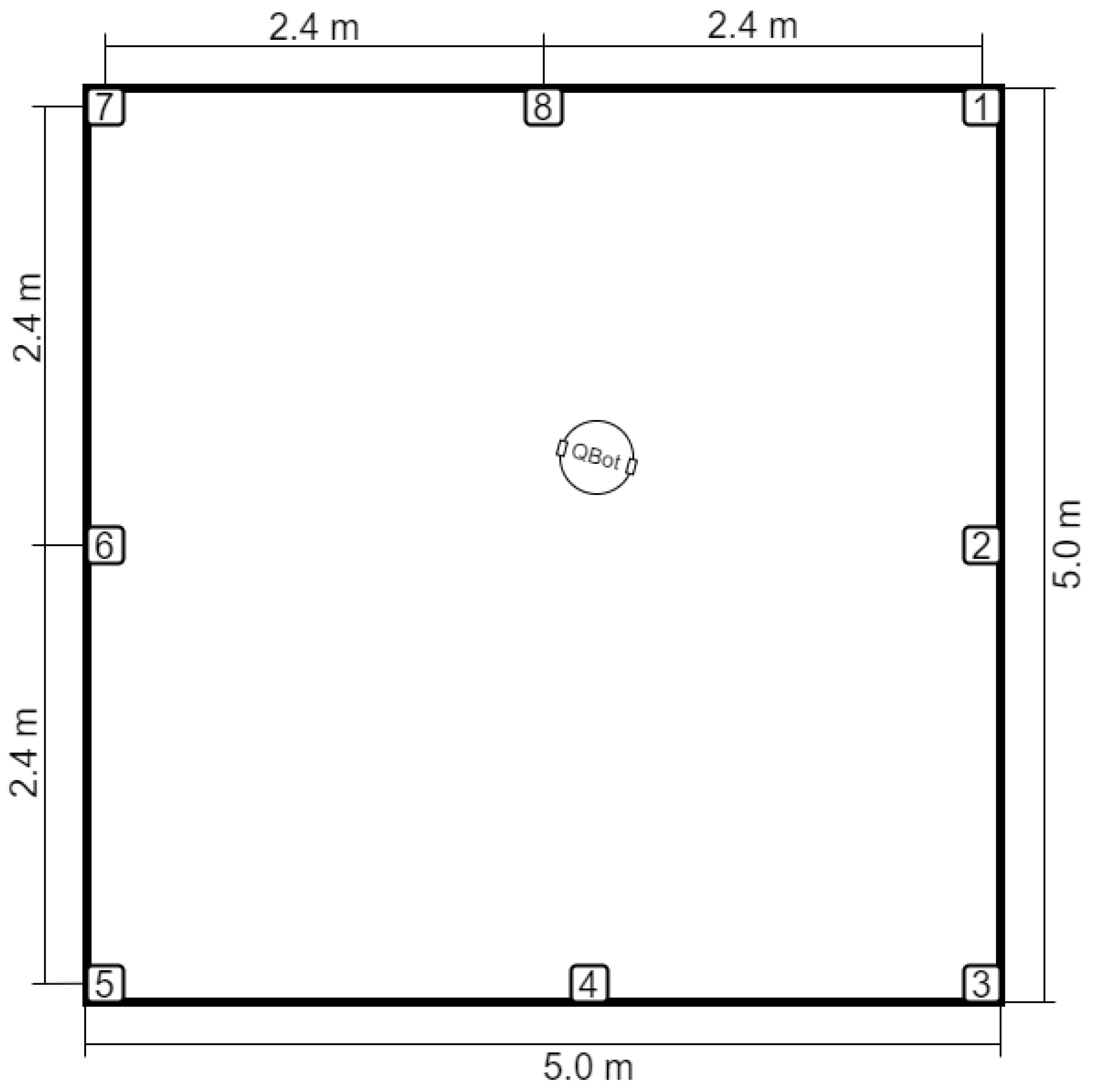
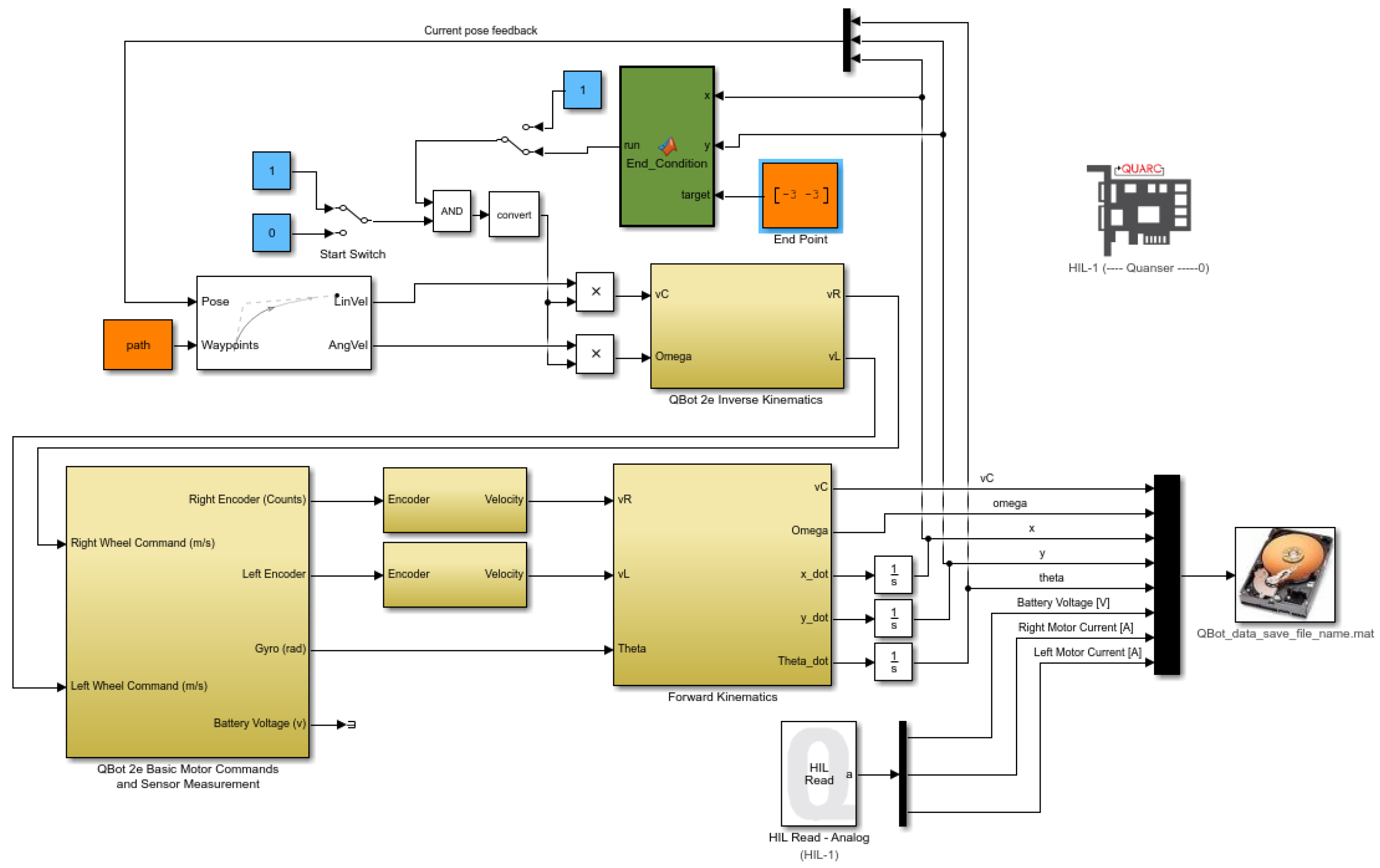
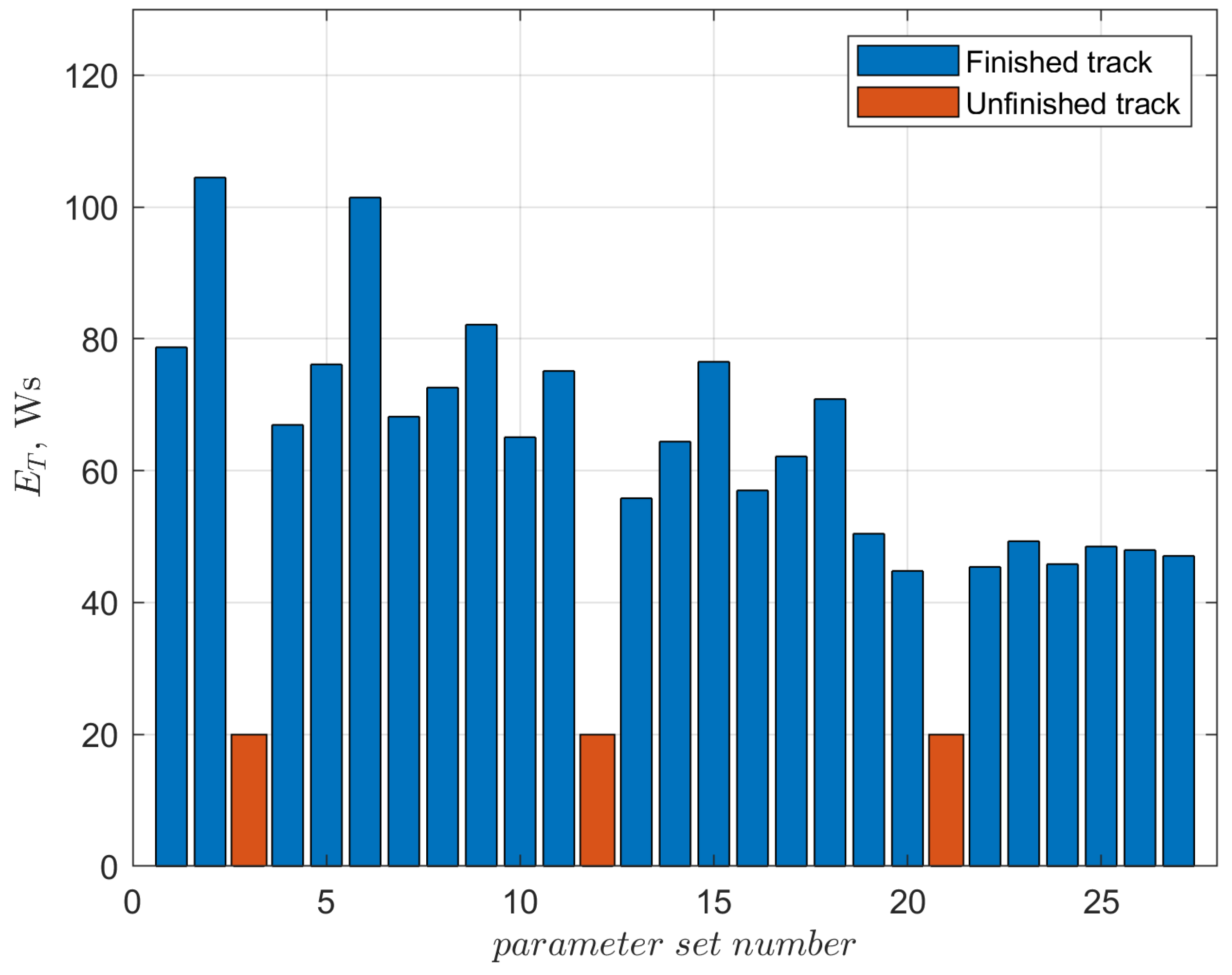
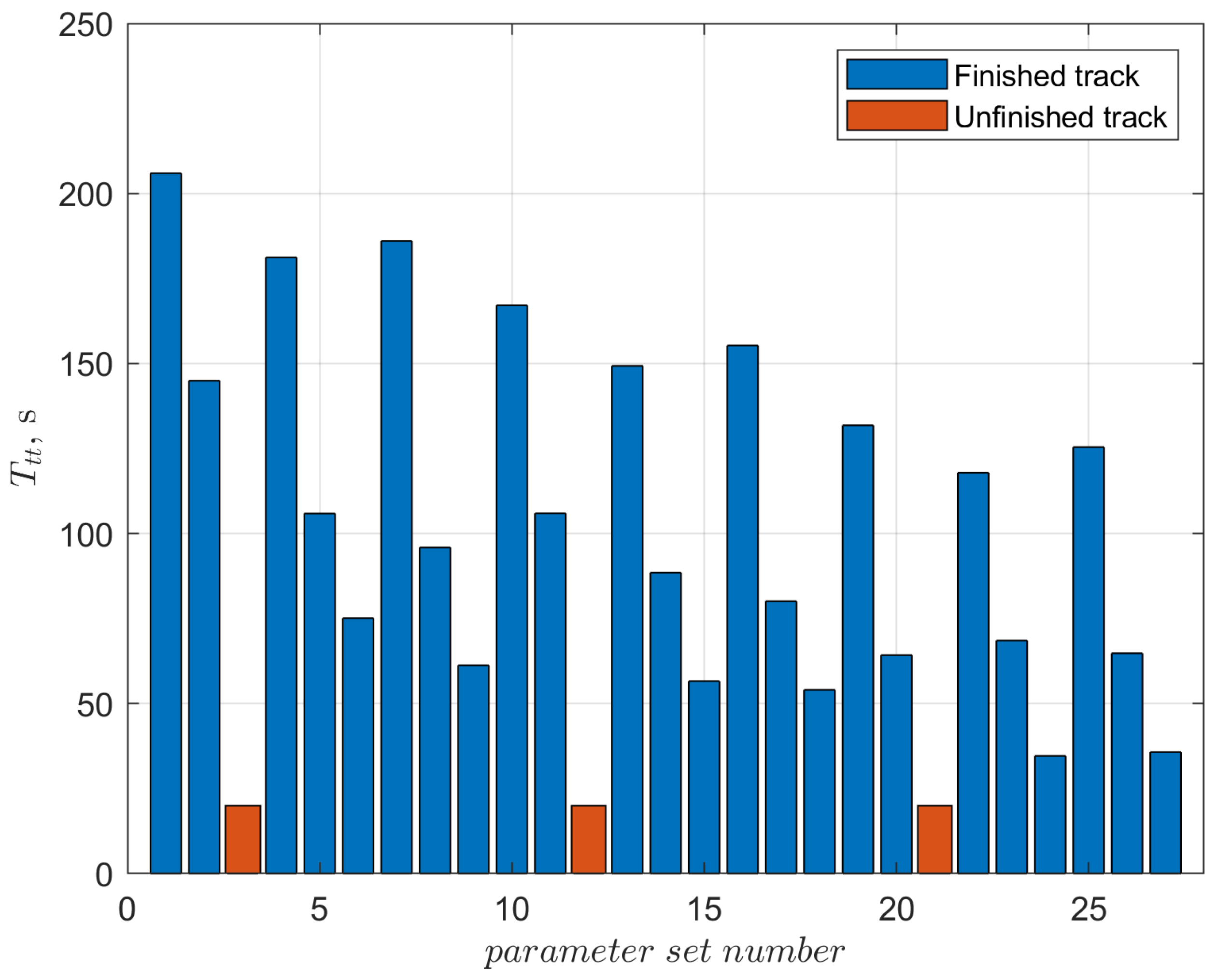
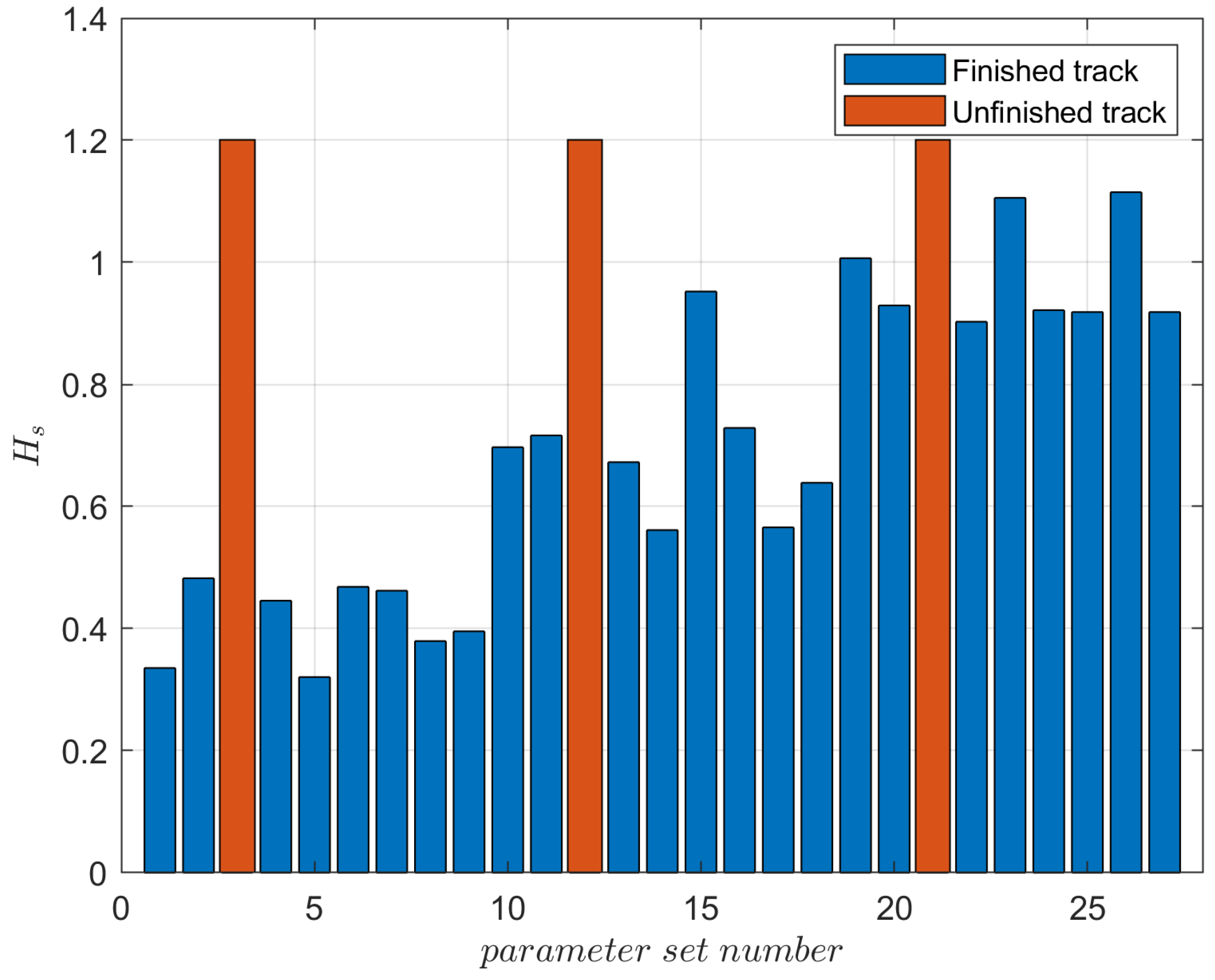
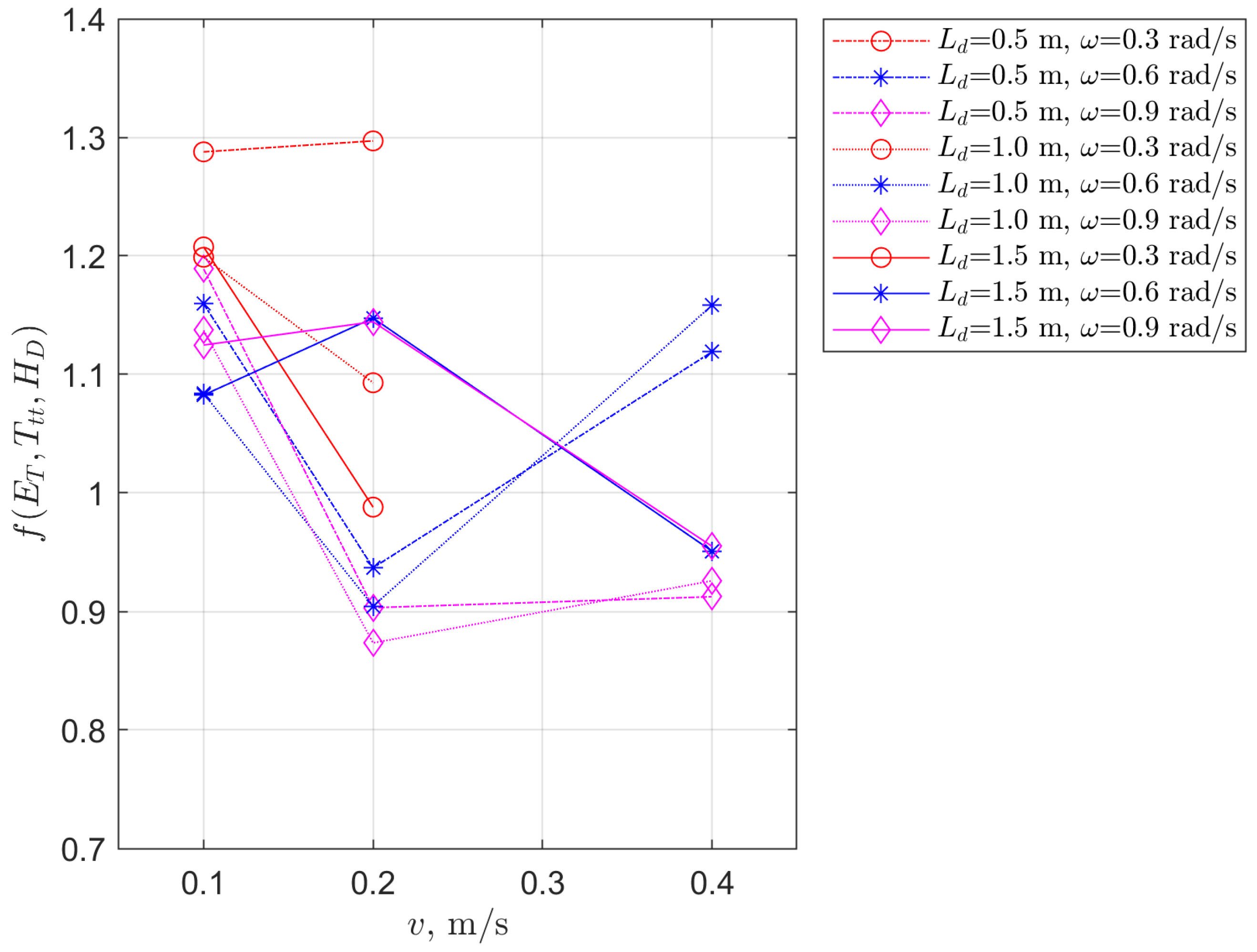
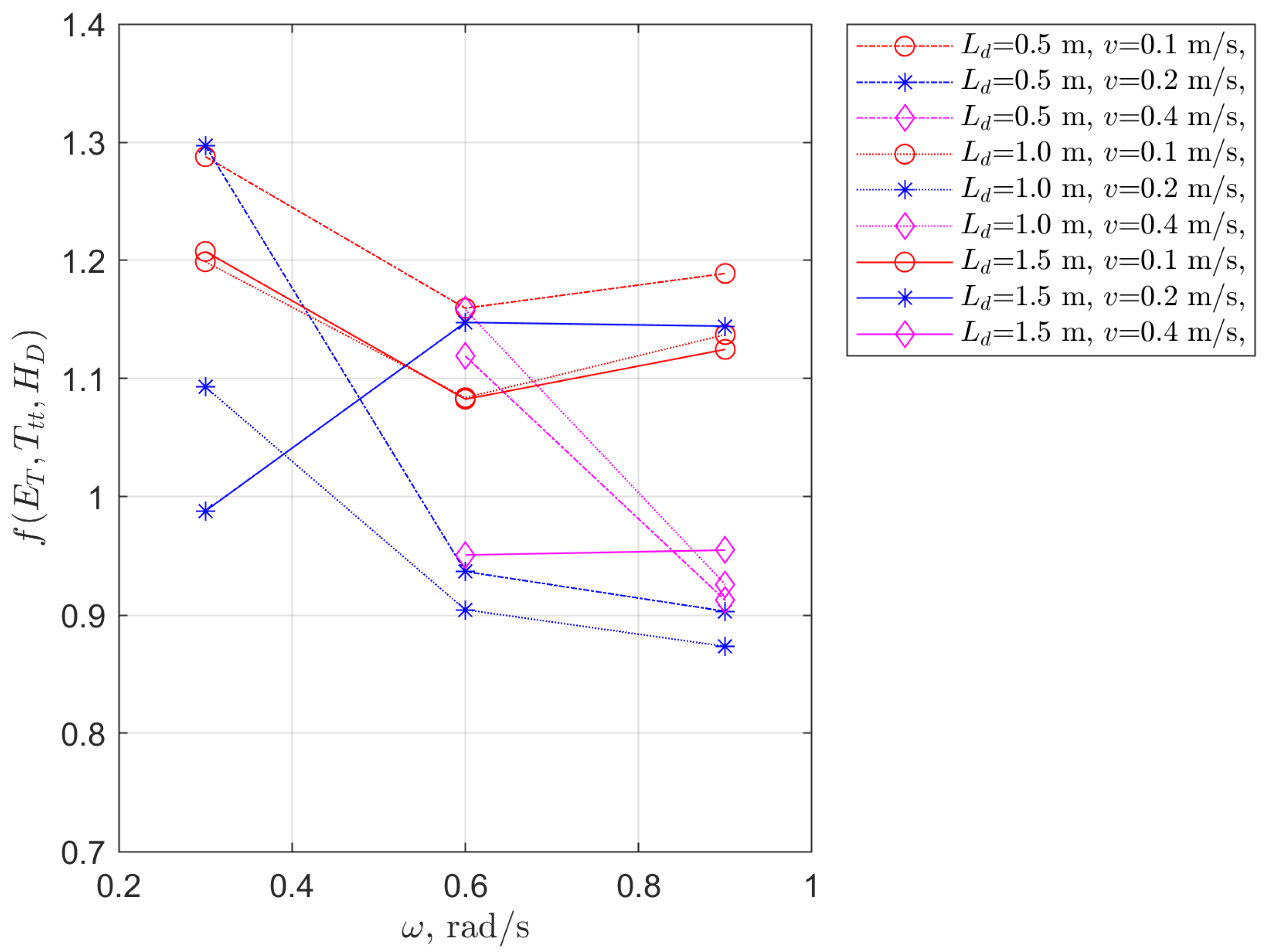

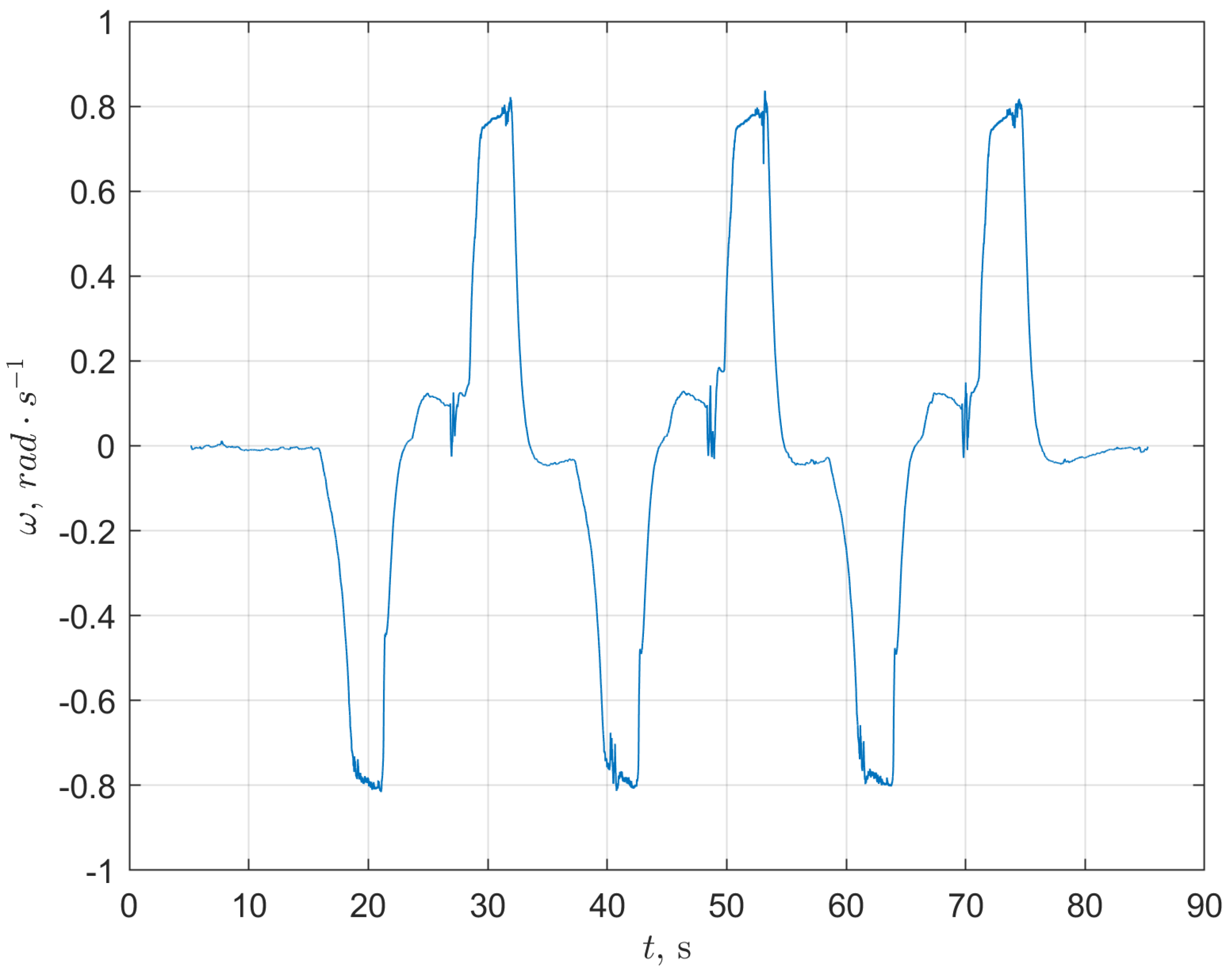
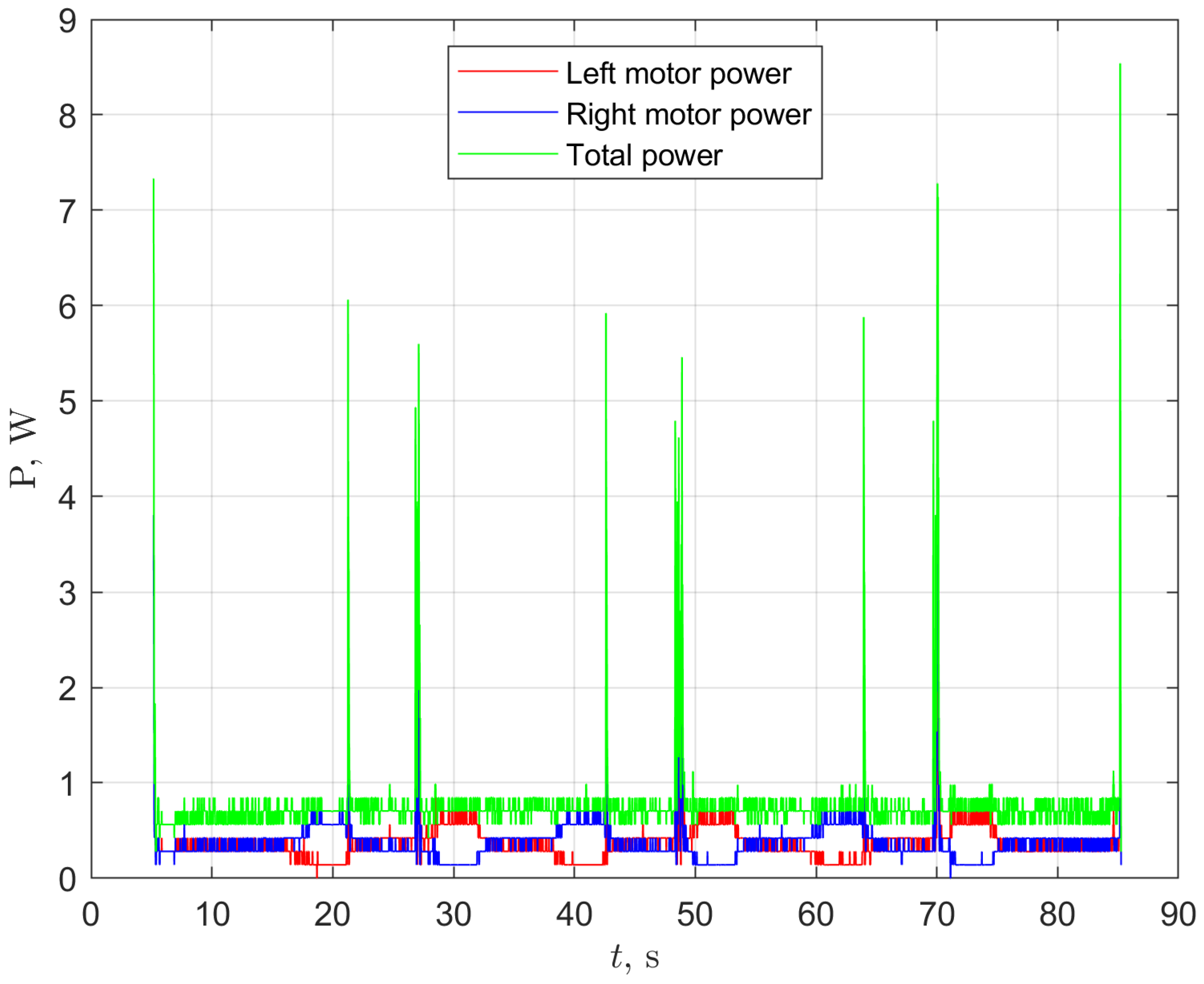
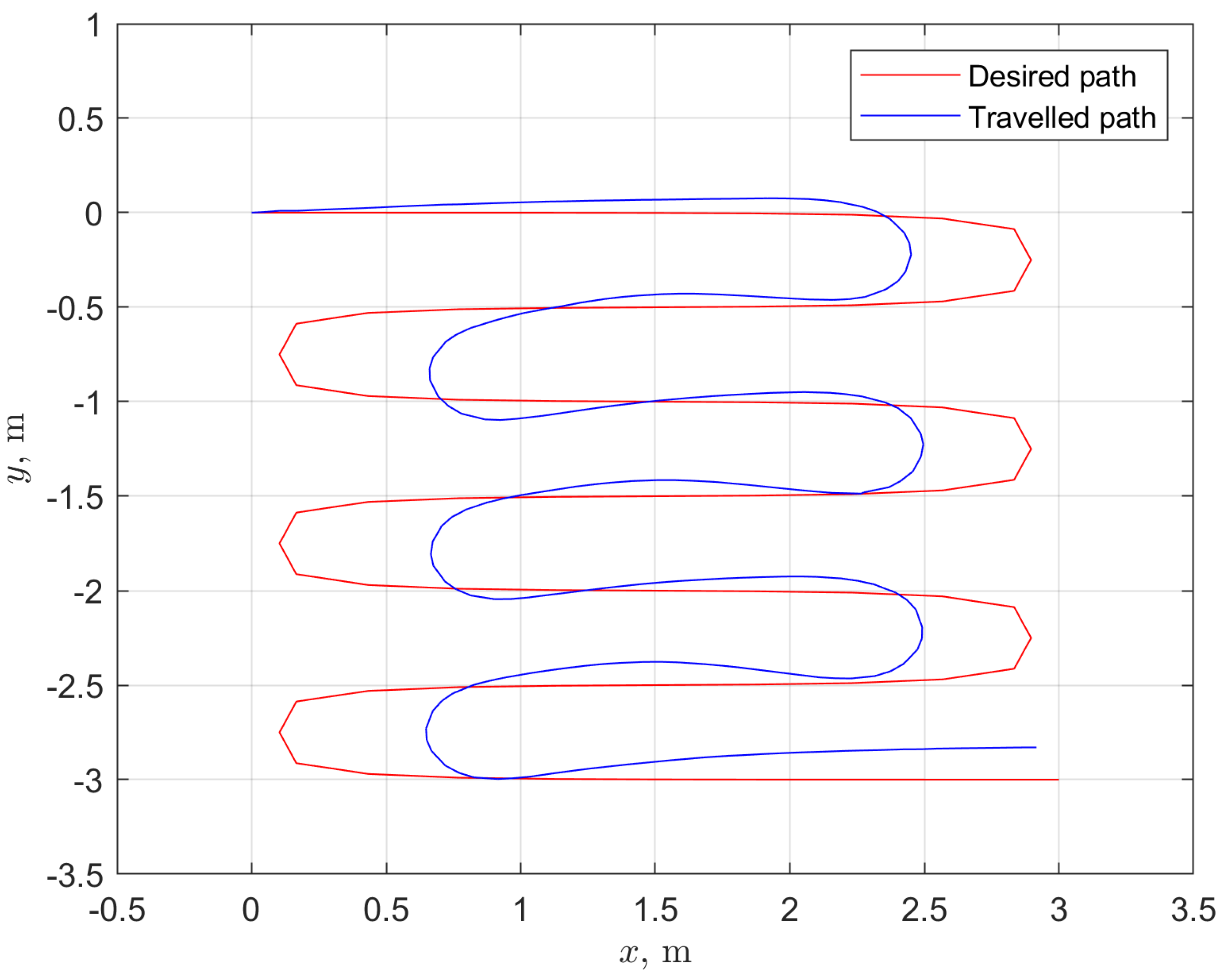
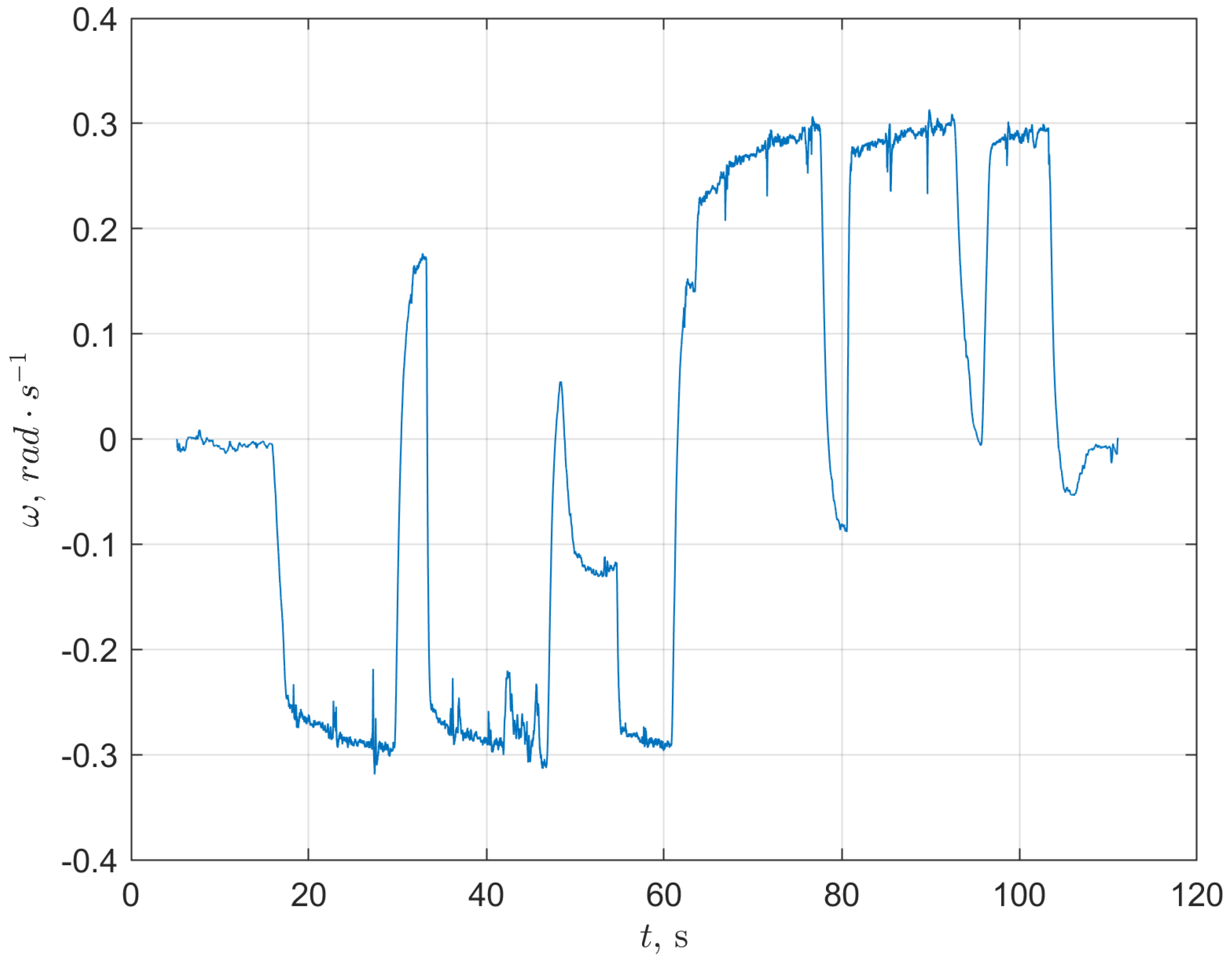
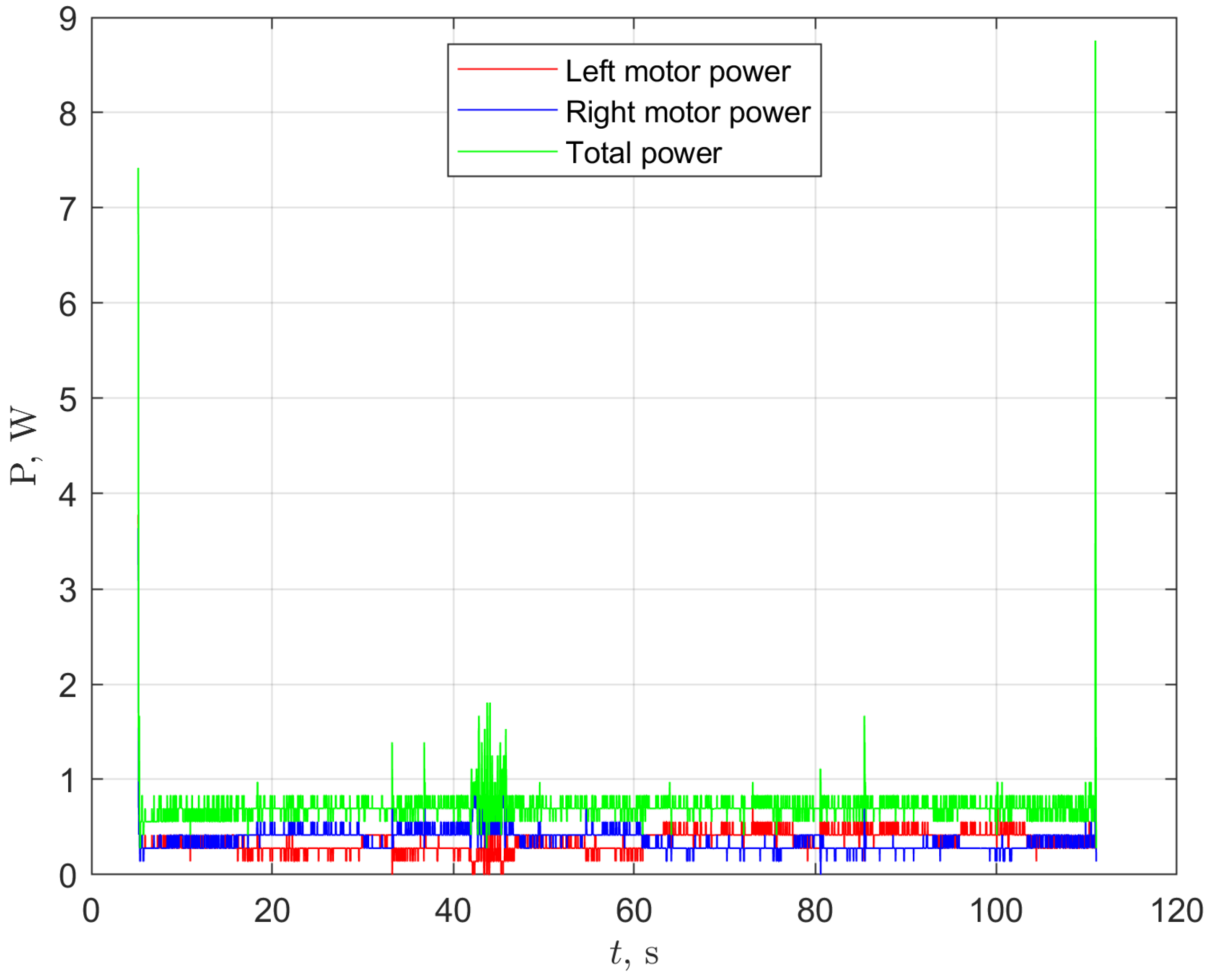

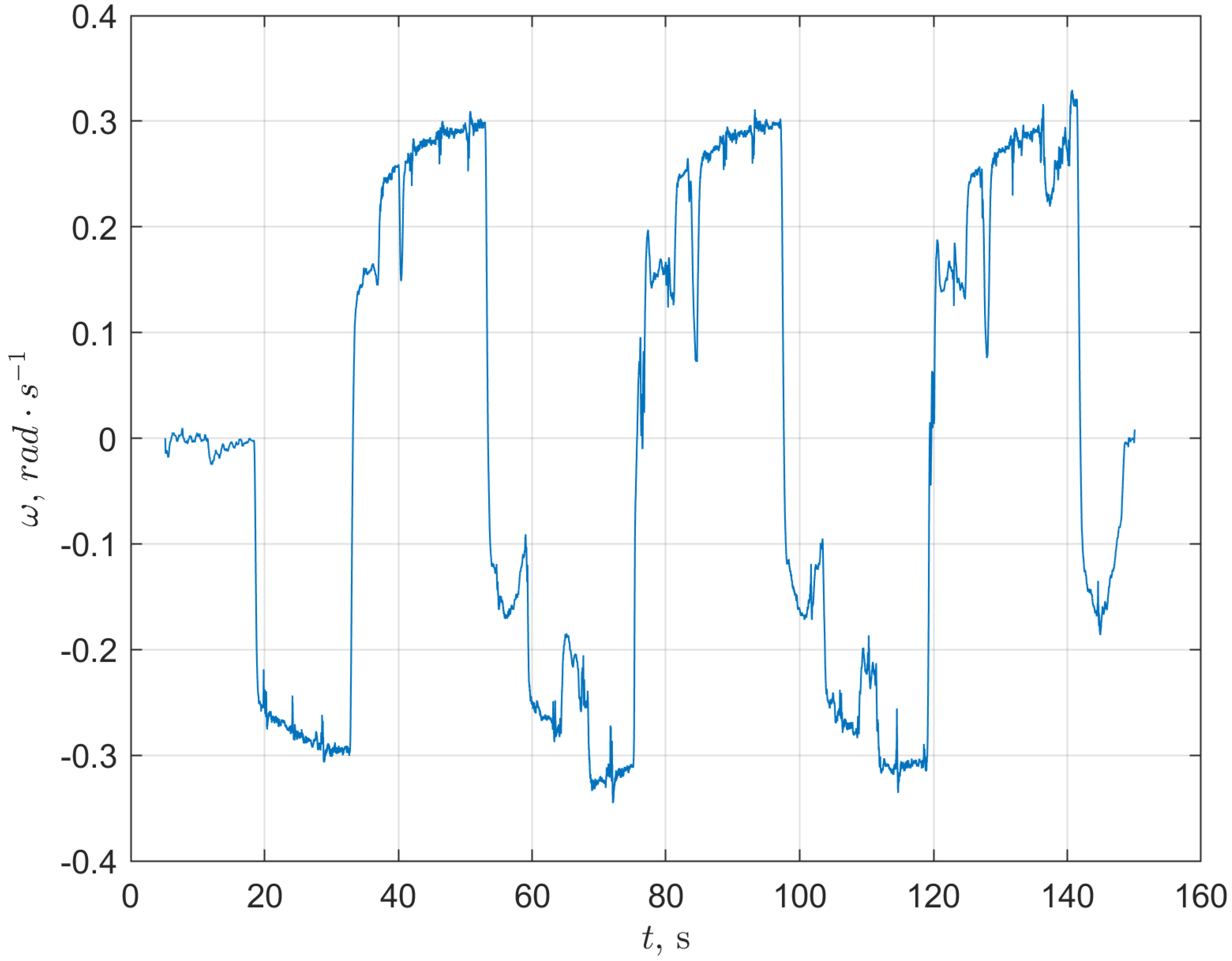
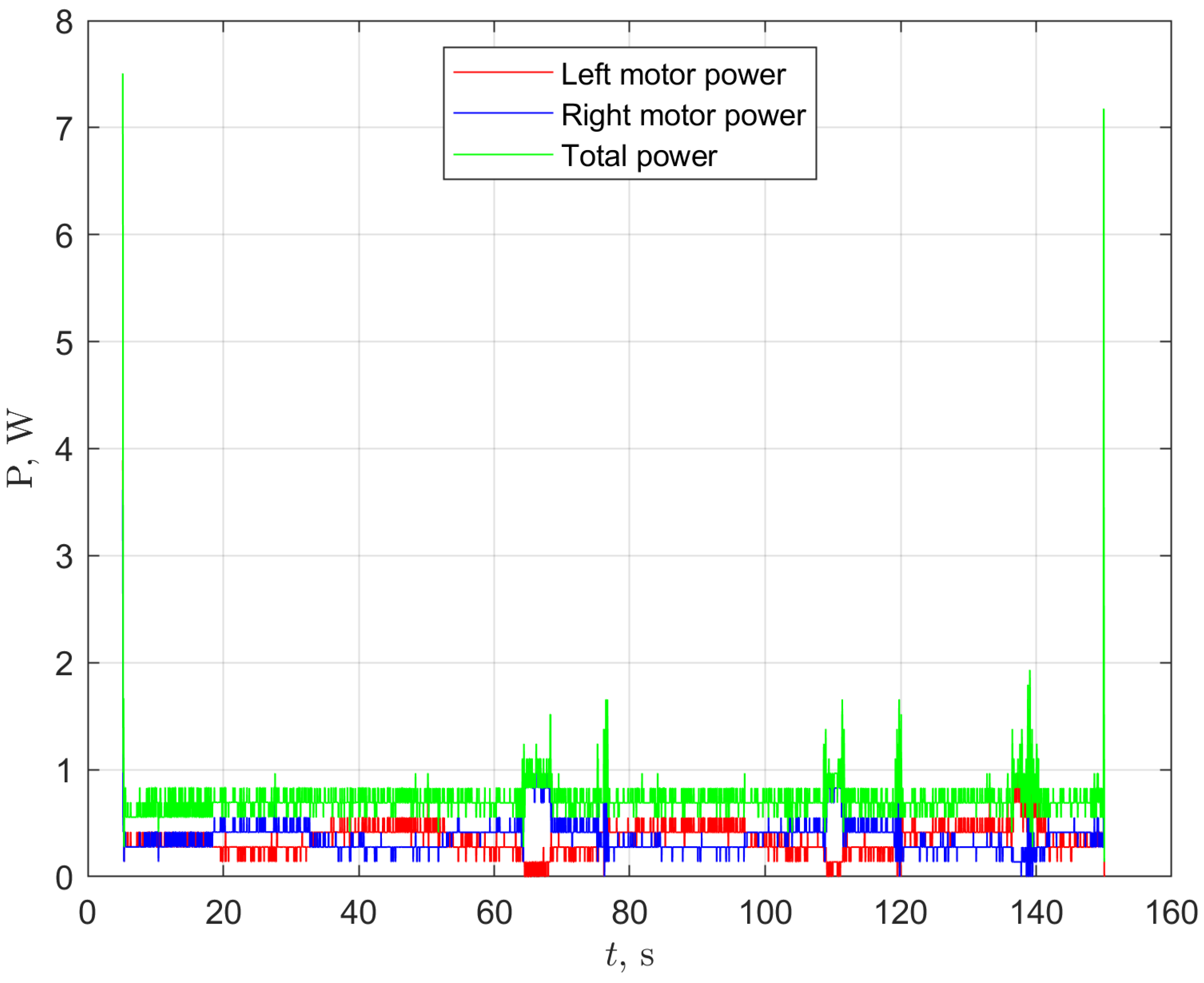
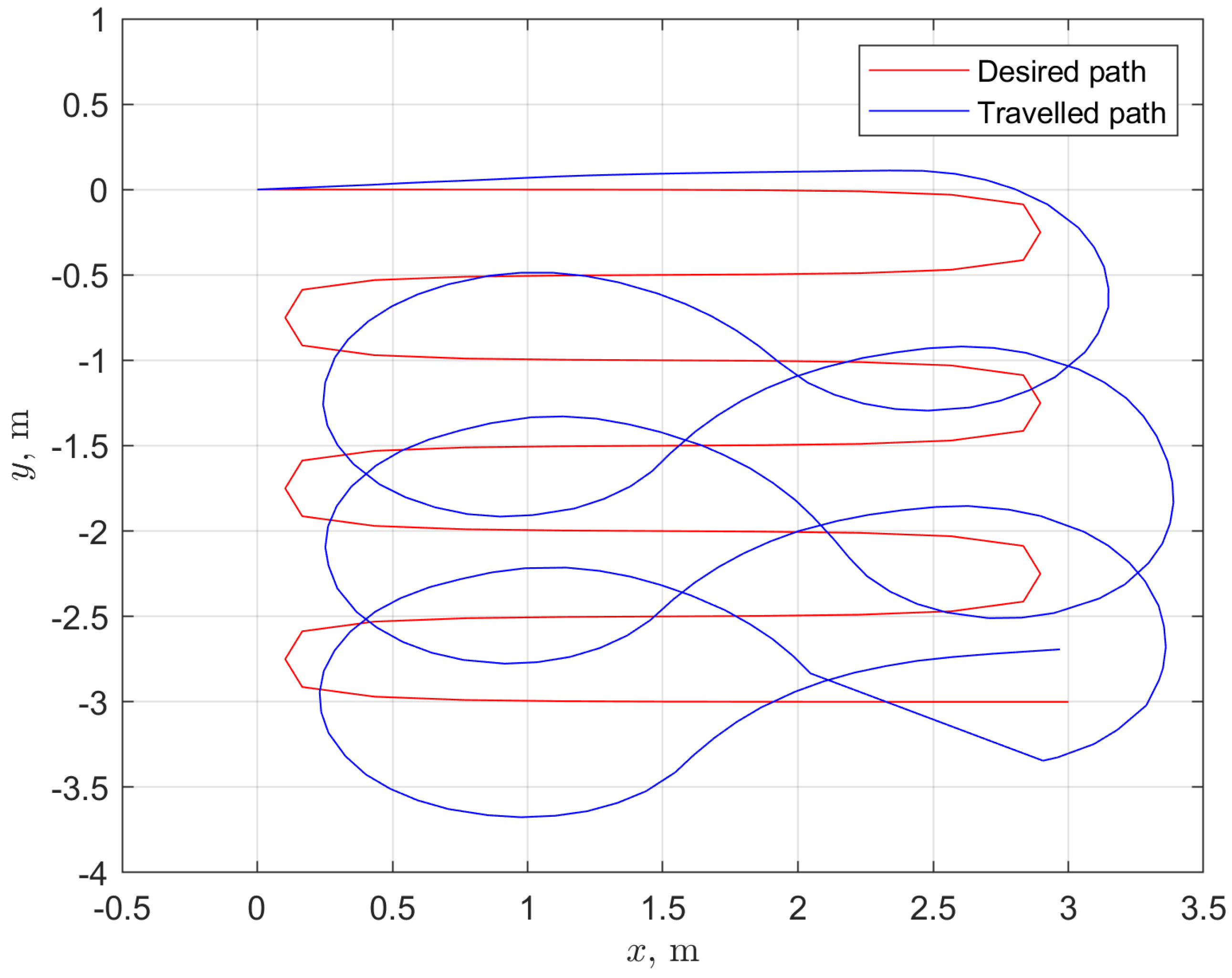
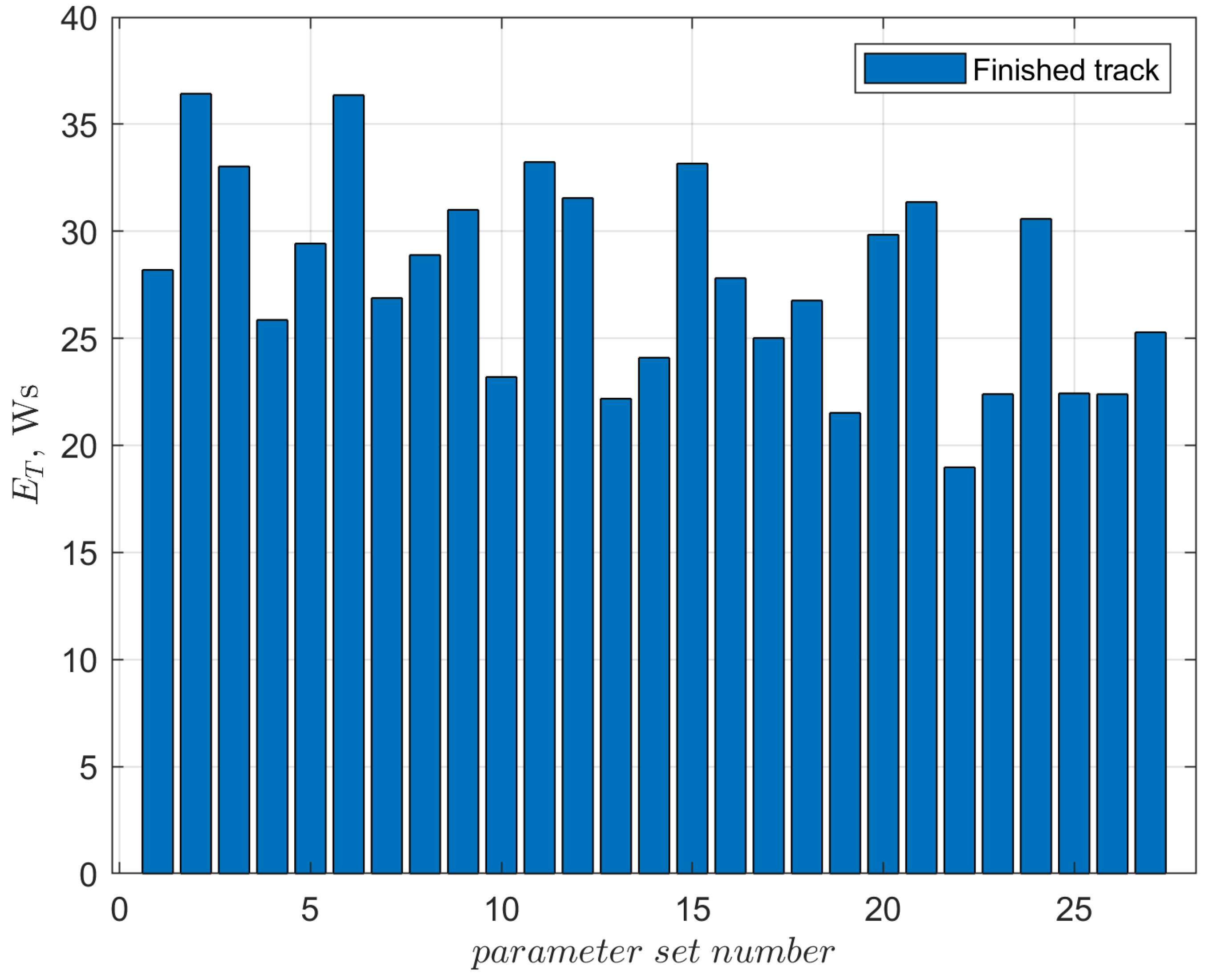


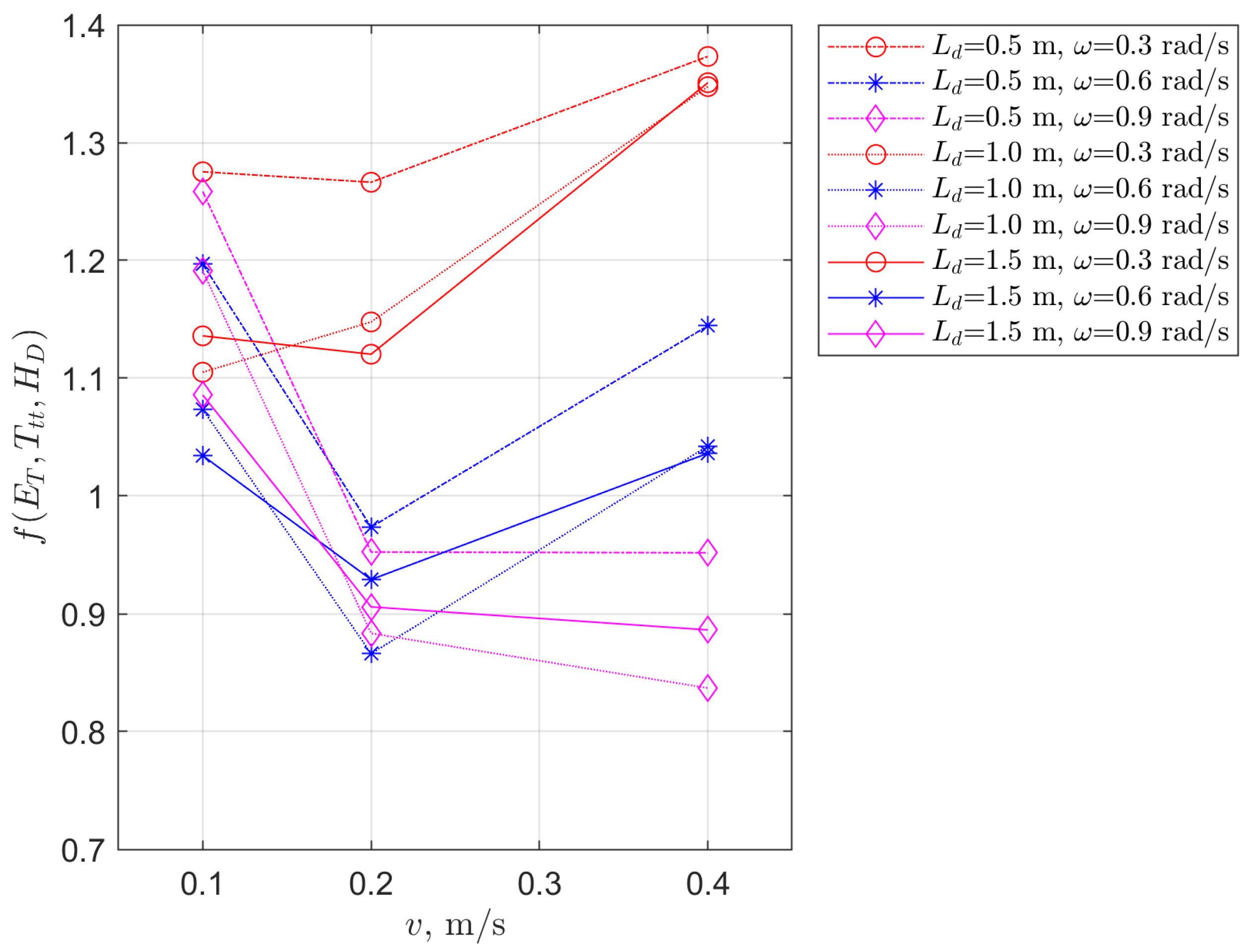
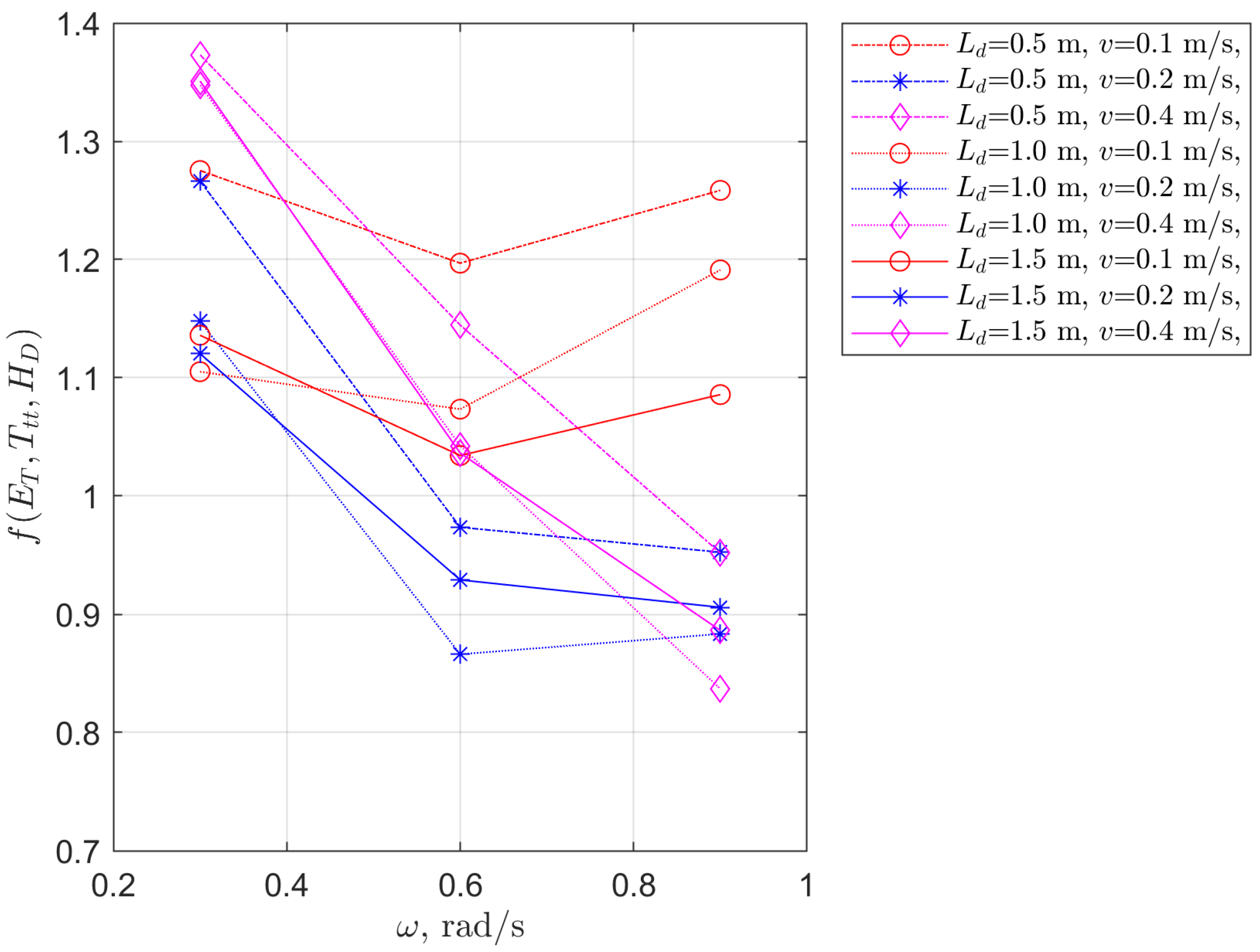

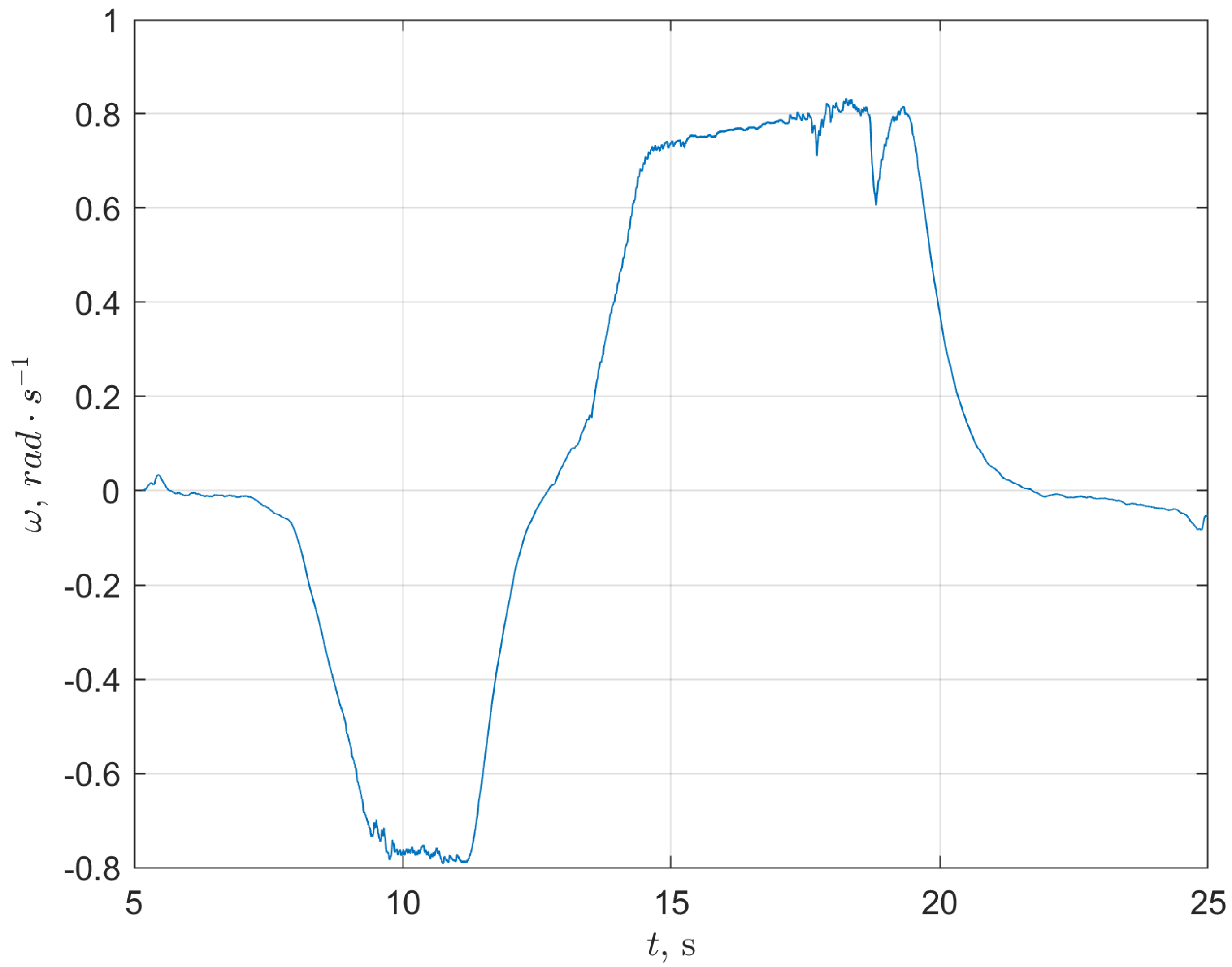
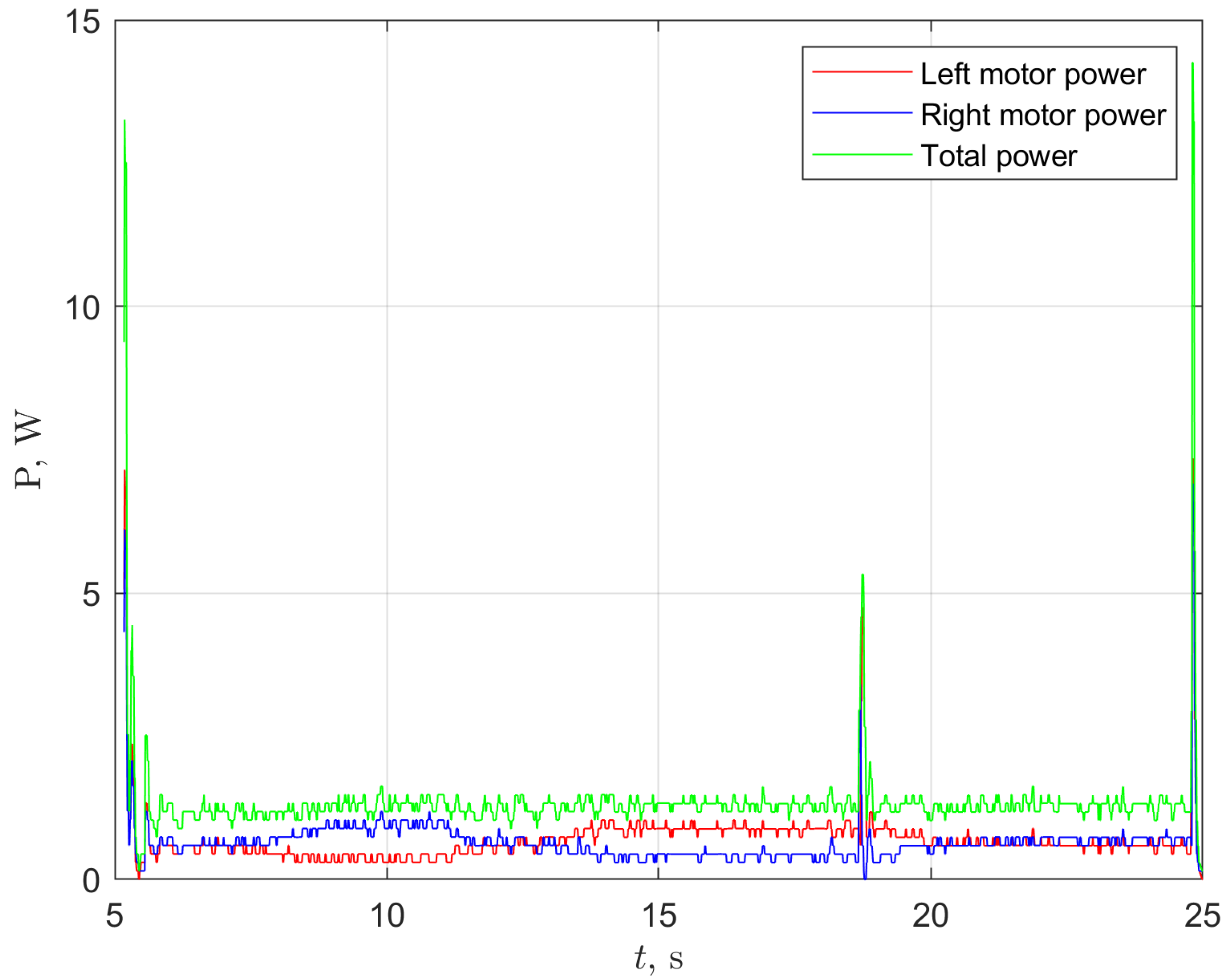
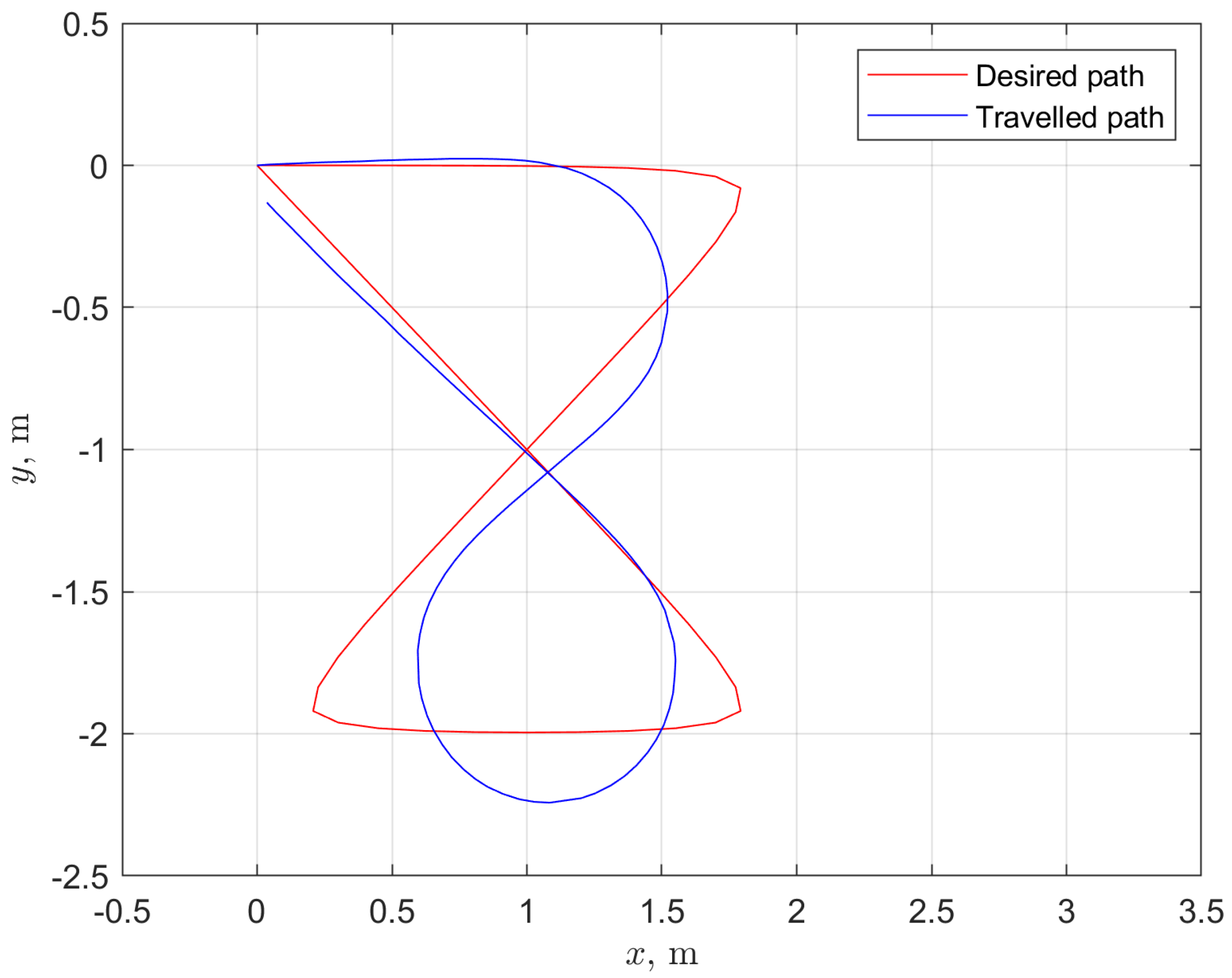
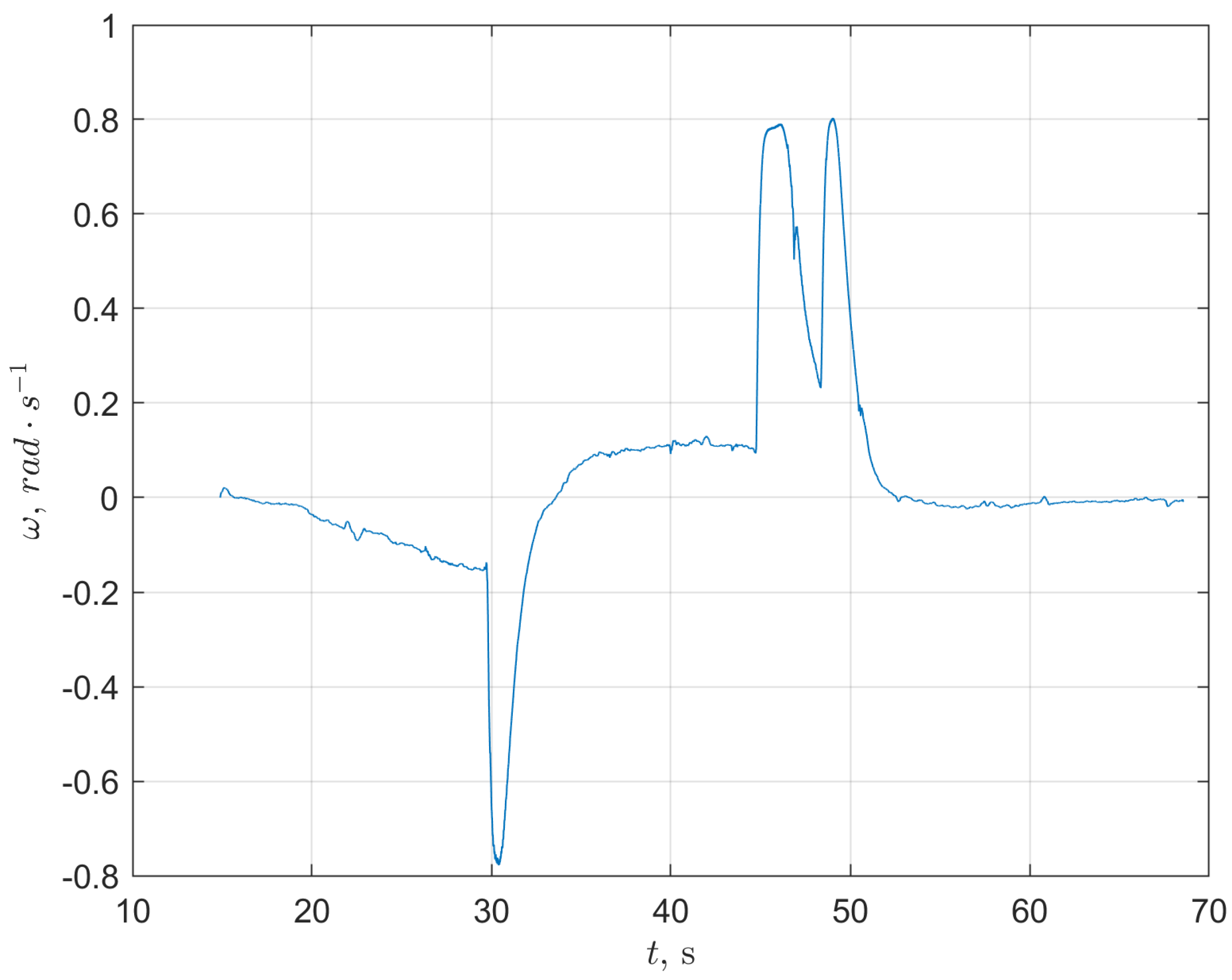
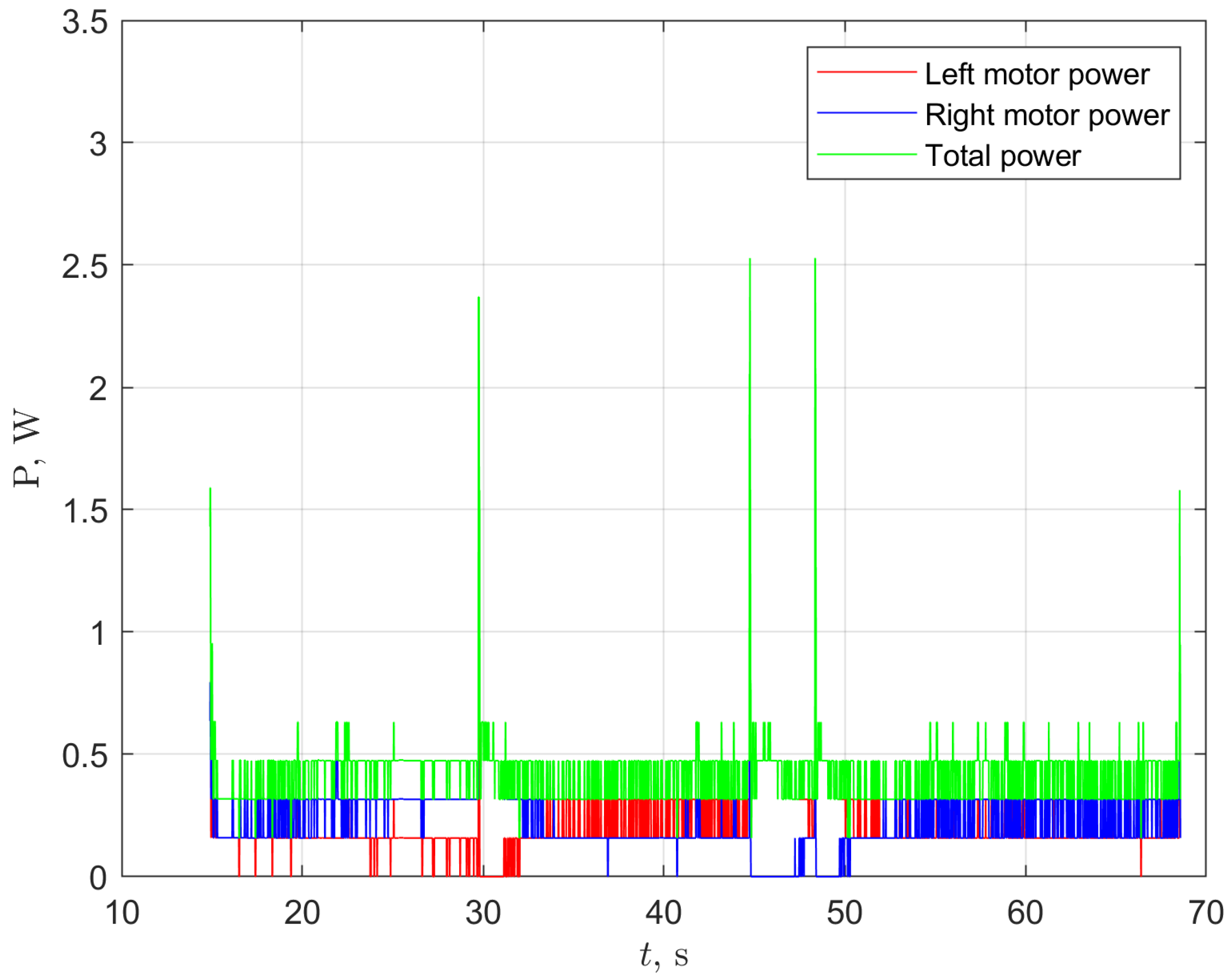
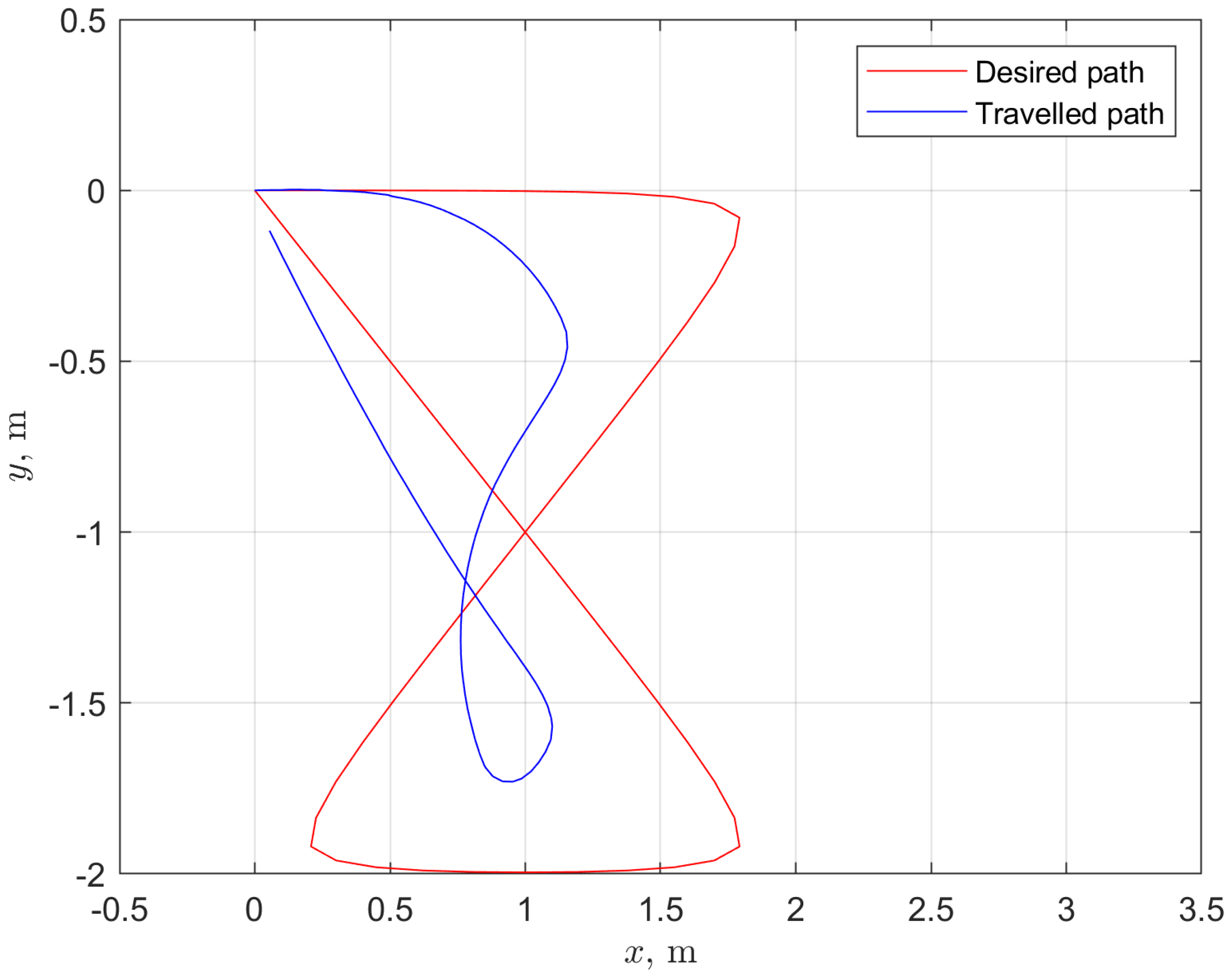
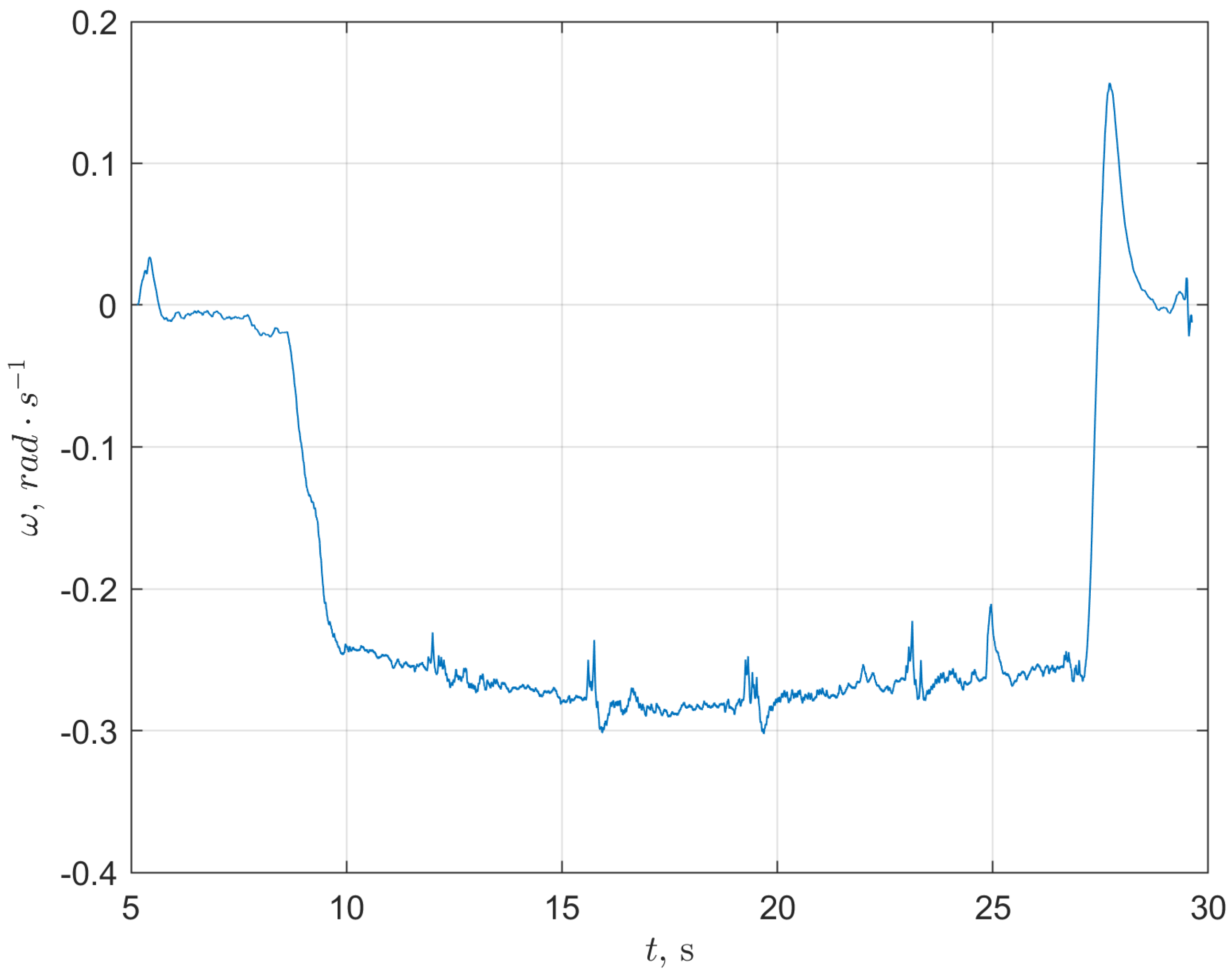
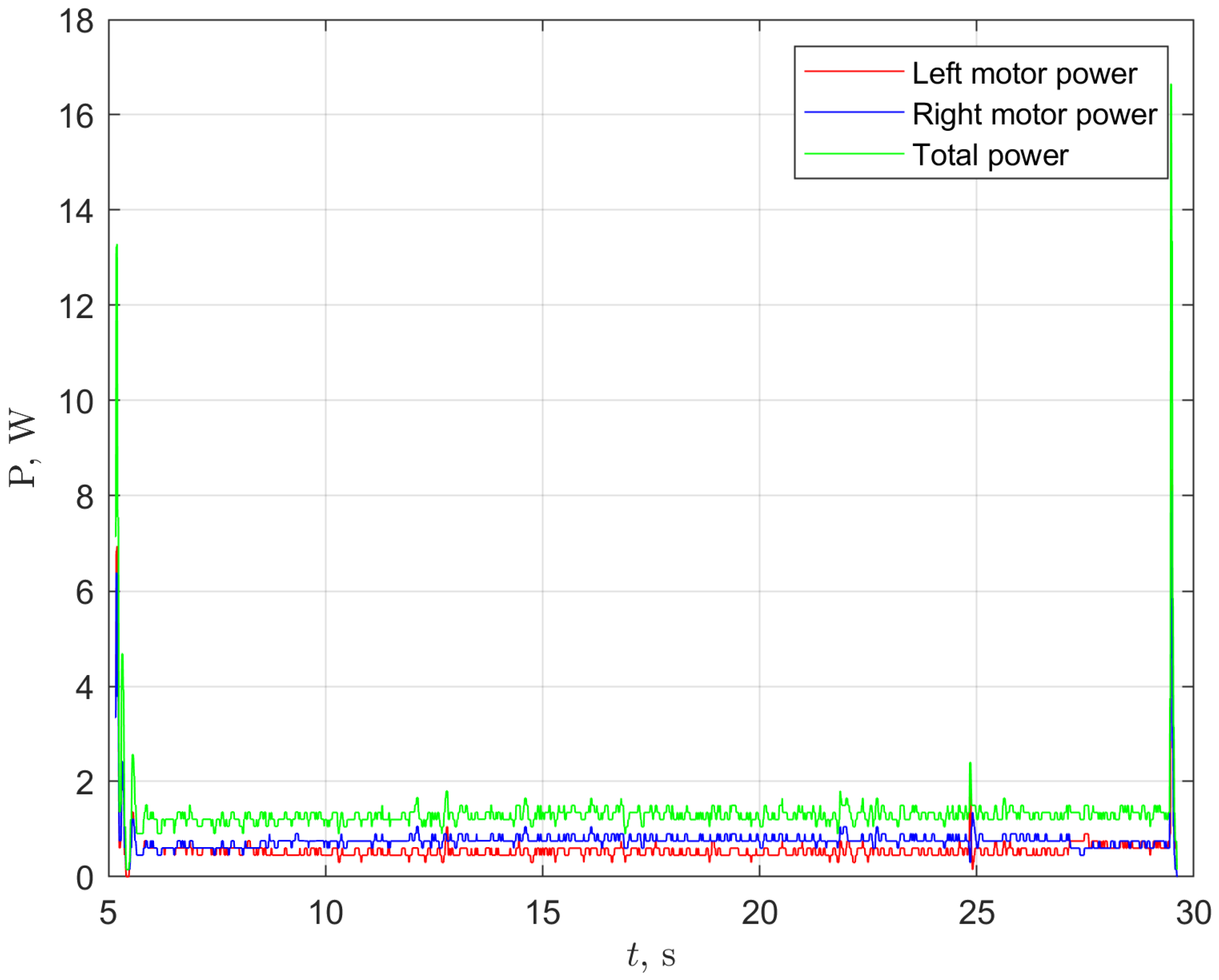
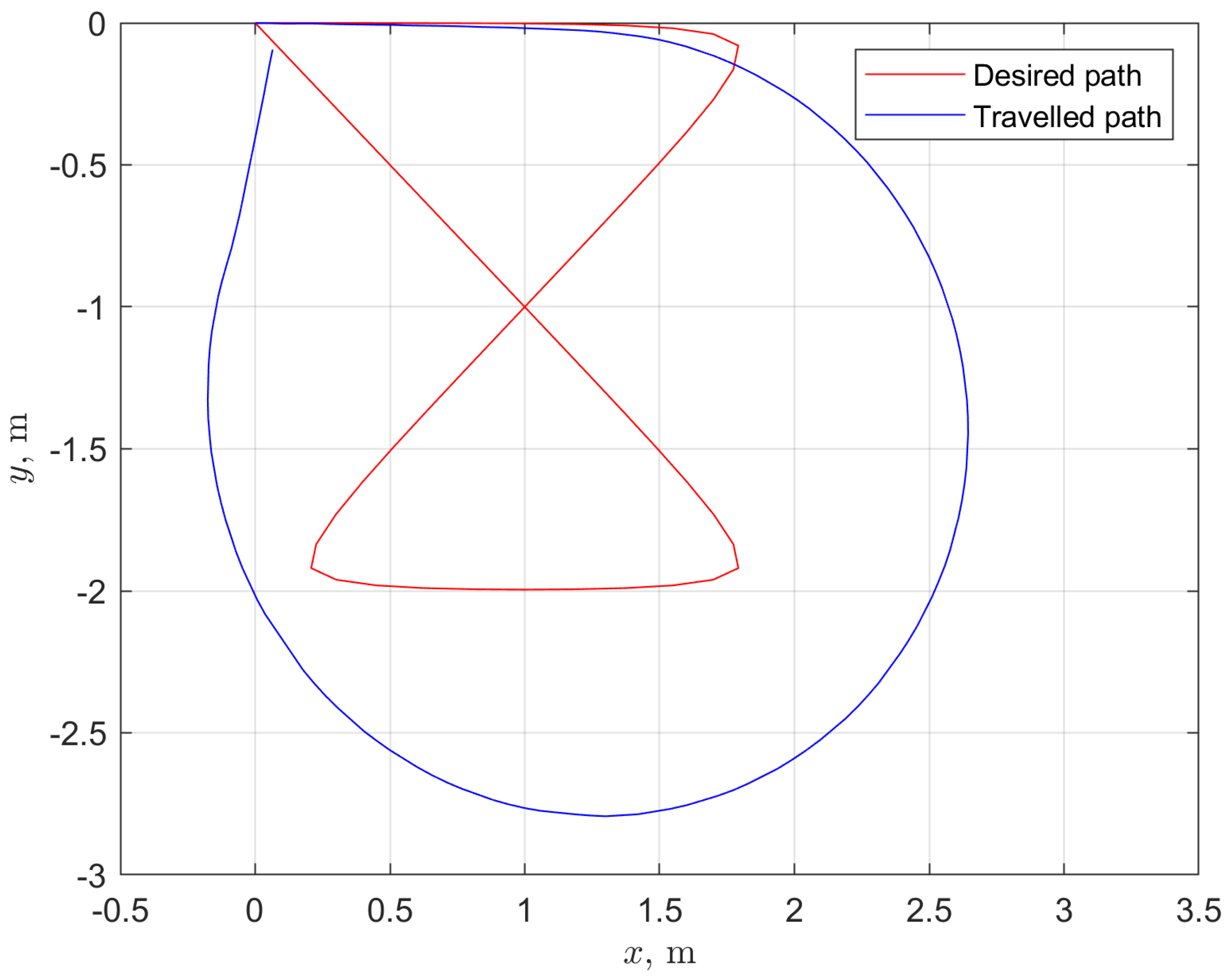
| Parameter Set Number | 1 | 2 | 3 | 4 | 5 | 6 | 7 | 8 | 9 | 10 | 11 | 12 | 13 | 14 |
|---|---|---|---|---|---|---|---|---|---|---|---|---|---|---|
| v (m/s) | 0.1 | 0.2 | 0.4 | 0.1 | 0.2 | 0.4 | 0.1 | 0.2 | 0.4 | 0.1 | 0.2 | 0.4 | 0.1 | 0.2 |
| (rad · s | 0.3 | 0.3 | 0.3 | 0.6 | 0.6 | 0.6 | 0.9 | 0.9 | 0.9 | 0.3 | 0.3 | 0.3 | 0.6 | 0.6 |
| (m) | 0.5 | 0.5 | 0.5 | 0.5 | 0.5 | 0.5 | 0.5 | 0.5 | 0.5 | 1.0 | 1.0 | 1.0 | 1.0 | 1.0 |
| ParameterSetNumber | 15 | 16 | 17 | 18 | 19 | 20 | 21 | 22 | 23 | 24 | 25 | 26 | 27 | |
| v (m/s) | 0.4 | 0.1 | 0.2 | 0.4 | 0.1 | 0.2 | 0.4 | 0.1 | 0.2 | 0.4 | 0.1 | 0.2 | 0.4 | |
| (rad · s | 0.6 | 0.9 | 0.9 | 0.9 | 0.3 | 0.3 | 0.3 | 0.6 | 0.6 | 0.6 | 0.9 | 0.9 | 0.9 | |
| (m) | 1.0 | 1.0 | 1.0 | 1.0 | 1.5 | 1.5 | 1.5 | 1.5 | 1.5 | 1.5 | 1.5 | 1.5 | 1.5 |
| Parameter Set Number | v (m/s) | (rad · s | (m) |
|---|---|---|---|
| 3 | 0.4 | 0.3 | 0.5 |
| 12 | 0.4 | 0.3 | 1.0 |
| 21 | 0.4 | 0.3 | 1.5 |
Disclaimer/Publisher’s Note: The statements, opinions and data contained in all publications are solely those of the individual author(s) and contributor(s) and not of MDPI and/or the editor(s). MDPI and/or the editor(s) disclaim responsibility for any injury to people or property resulting from any ideas, methods, instructions or products referred to in the content. |
© 2023 by the authors. Licensee MDPI, Basel, Switzerland. This article is an open access article distributed under the terms and conditions of the Creative Commons Attribution (CC BY) license (https://creativecommons.org/licenses/by/4.0/).
Share and Cite
Szeląg, P.; Dudzik, S.; Podsiedlik, A. Investigation on the Mobile Wheeled Robot in Terms of Energy Consumption, Travelling Time and Path Matching Accuracy. Energies 2023, 16, 1210. https://doi.org/10.3390/en16031210
Szeląg P, Dudzik S, Podsiedlik A. Investigation on the Mobile Wheeled Robot in Terms of Energy Consumption, Travelling Time and Path Matching Accuracy. Energies. 2023; 16(3):1210. https://doi.org/10.3390/en16031210
Chicago/Turabian StyleSzeląg, Piotr, Sebastian Dudzik, and Anna Podsiedlik. 2023. "Investigation on the Mobile Wheeled Robot in Terms of Energy Consumption, Travelling Time and Path Matching Accuracy" Energies 16, no. 3: 1210. https://doi.org/10.3390/en16031210
APA StyleSzeląg, P., Dudzik, S., & Podsiedlik, A. (2023). Investigation on the Mobile Wheeled Robot in Terms of Energy Consumption, Travelling Time and Path Matching Accuracy. Energies, 16(3), 1210. https://doi.org/10.3390/en16031210







